
French Loaves
My kids love to aid me brand this delicious bread recipe. It's quite easy, and they savour the fact that they can be eating fresh bread in less than two hours! —Denise Boutin, Grand Island, Vermont
Psst! Brand bread a breeze with these essential bread-making tools.
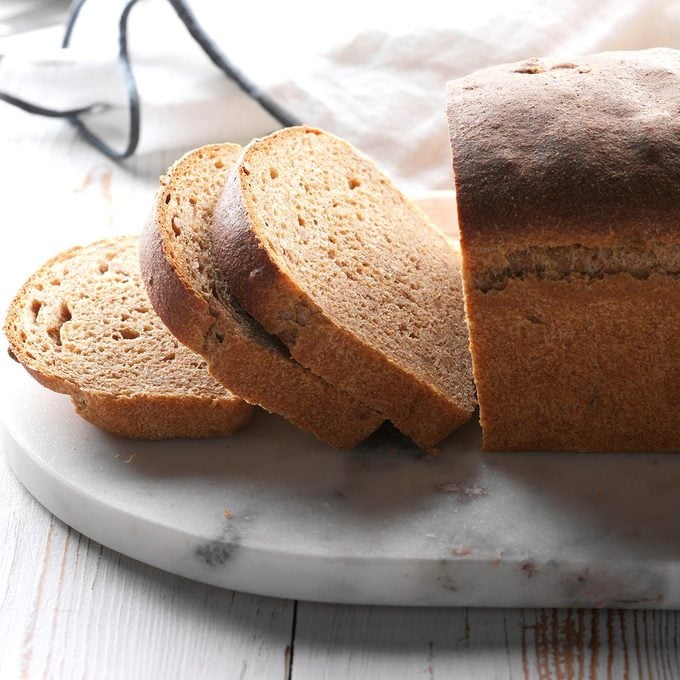
Sunflower Seed & Honey Wheat Bread
I've tried other bread recipes, but this 1 is a staple in our home. I won $fifty in a bake-off with a loaf that I had stored in the freezer. —Mickey Turner, Grants Pass, Oregon
Want a breadstuff baking refresher? Check out our bread baking guide and become all of your questions answered (or but become some reassurance).
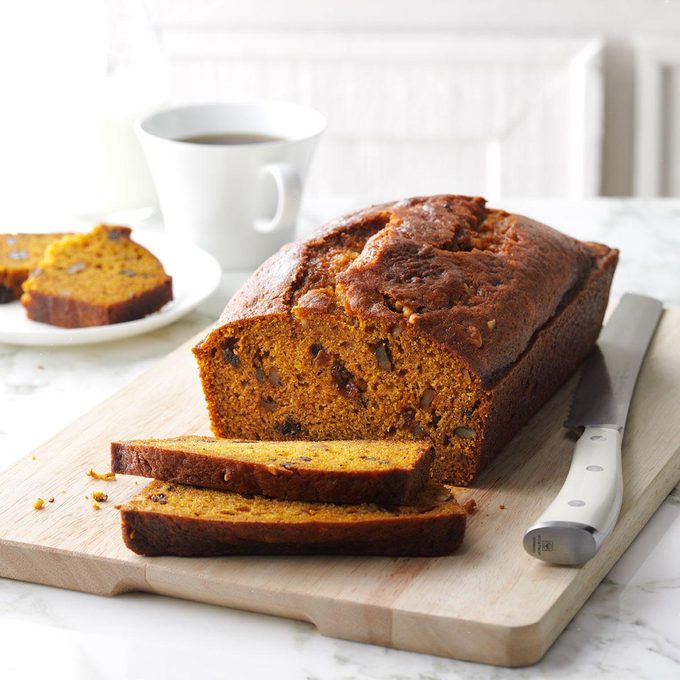
Pumpkin Staff of life
I continue my freezer stocked for our harvest crew with home-baked goodies like this deliciously spicy, like shooting fish in a barrel pumpkin bread recipe. —Joyce Jackson, Bridgetown, Nova Scotia (Find more than piece of cake quick bread recipes like this one!)

Basic Homemade Bread
If you'd like to learn how to bake bread, here'due south a wonderful identify to start. This like shooting fish in a barrel white staff of life recipe bakes up deliciously golden brown. At that place'southward nothing similar the homemade smell wafting through my kitchen as it bakes. —Sandra Anderson, New York, New York Learn more than well-nigh all of the unlike types of staff of life—from yeast breads like this one to quick breads, shaped breads, sweet breads and more than!

Best Ever Assistant Bread
Whenever I pass a display of bananas in the grocery store, I can almost odour the wonderful aroma of my best banana bread recipe. Information technology really is amazingly good! —Gert Kaiser, Kenosha, Wisconsin

Baker's Dozen Yeast Rolls
A yummy honey-garlic topping turns these easy dinner rolls into something actress special. Attempt 'em with soups and chili. —Taste of Dwelling Exam Kitchen

Buttery Cornbread
A friend gave me this cornbread recipe several years ago, and it's my favorite of all I've tried. I love to serve the melt-in-your rima oris cornbread hot from the oven with butter and syrup. It gets rave reviews on holidays and at potluck dinners. —Nicole Callen, Auburn, California
Oatmeal Dinner Rolls
These fluffy rolls go perfectly with any repast. They accept a delicious bootleg flavor that's irresistible. I similar them considering they're not hard to make and they broil upward dainty and high. —Patricia Staudt, Marble Rock, Iowa
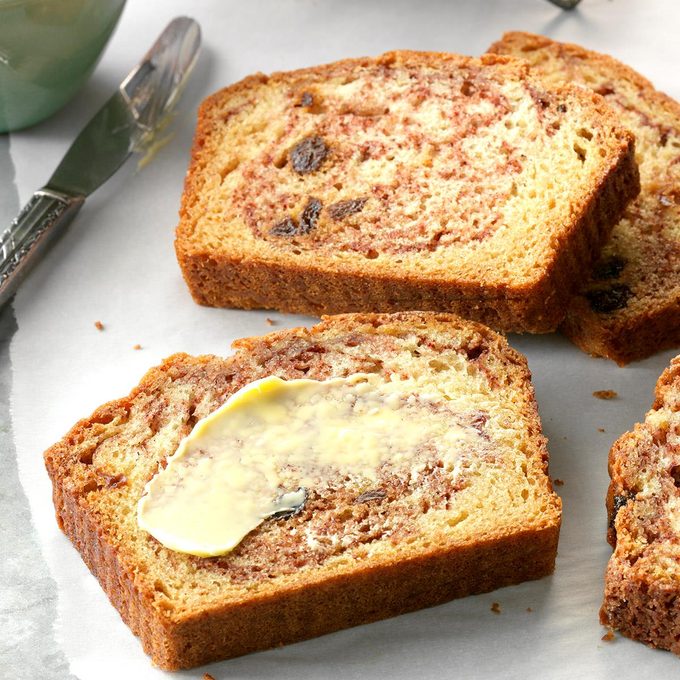
Cinnamon Raisin Quick Bread
Cinnamon and raisins bring heartwarming flavor to this mildly sweet bread. It's ideal for an on-the-go breakfast or a quick snack before dinner. —Flo Burtnett, Cuff, Oklahoma
Have a expect at these cranberry bread recipes.
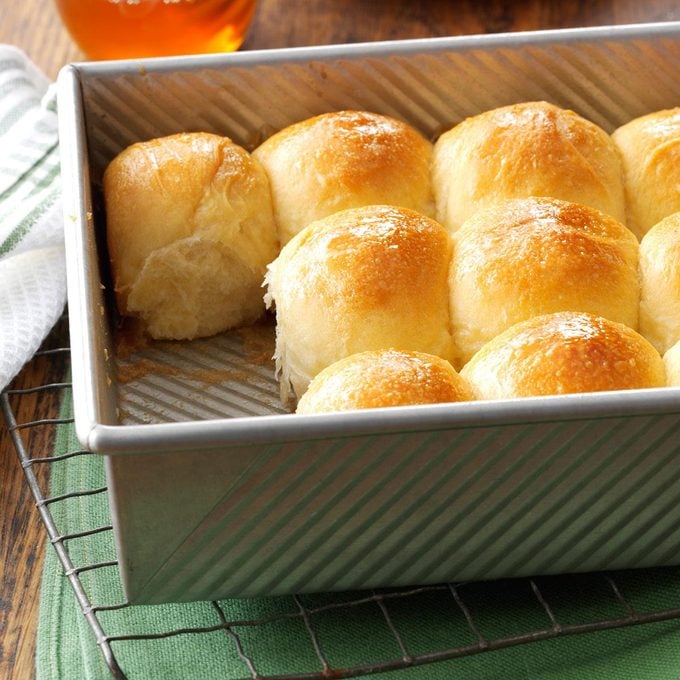
Golden Honey Pan Rolls
A cousin in N Carolina gave me the recipe for these delicious honey-glazed rolls. Using my bread machine to make the dough saves me about 2 hours compared to the traditional method. The rich buttery gustatory modality of these rolls is so popular with family unit and friends that I unremarkably make 2 batches so I accept enough! —Sara Wing, Philadelphia, Pennsylvania
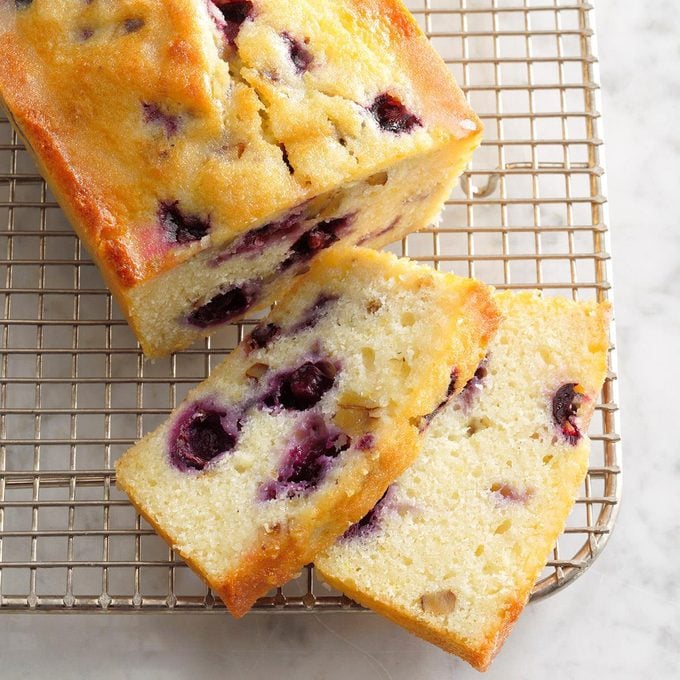
Lemon Blueberry Bread
Of all the quick breads we had growing up, this cute lemon blueberry bread is the best! The citrus glaze adds a lustrous finish and locks in wet. —Julianne Johnson, Grove Urban center, Minnesota

Icebox Butterhorns
These beautiful golden rolls just cook in your oral fissure! People will be impressed when these appear on your table. —Judy Clark, Elkhart, Indiana

Fresh Pear Bread
When our tree branches are loaded with ripe and juicy fruit, I treat my family and friends to lots of like shooting fish in a barrel pear recipes. I always receive raves and requests for this particular pear bread recipe because of the mix of fun ingredients.—Linda Patrick, Houston, Texas
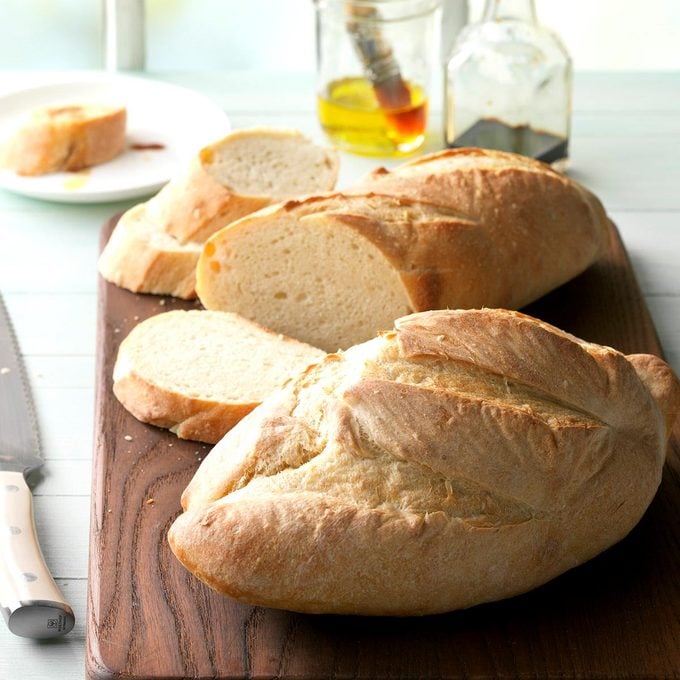
Mom's Italian Bread
I remember Mom used to bake at least 4 of these tender loaves at once, and they never lasted long. She served the bread with every Italian repast. I dearest information technology toasted, likewise. —Linda Harrington, Windham, New Hampshire
Apple Zucchini Bread
Since apples and zucchini are and so arable in this surface area, it'southward only natural that the two be used together in one recipe. I really don't know the origin of this bread, only I do know it'south been one of my favorites for many years. —Patti Dillingham, Scranton, Arkansas
Here'due south more than on how to make zucchini bread.
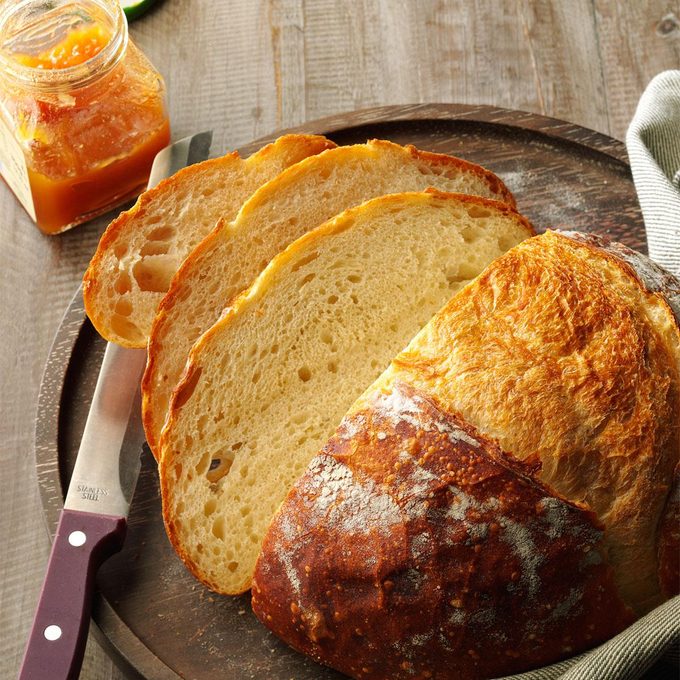
Crusty Homemade Bread
Crackling homemade bread makes an average day extraordinary. Relish this beautiful crusty breadstuff recipe as is, or stir in a few favorites like cheese, garlic, herbs and dried fruits. —Megumi Garcia, Milwaukee, Wisconsin
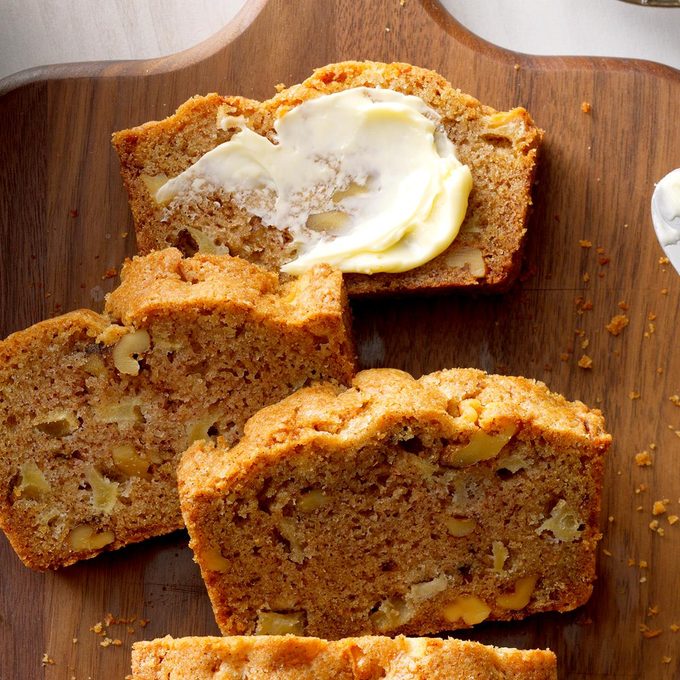
Apple Breadstuff
I got this apple tree quick breadstuff recipe a long time ago and with a few changes it's become one of our favorites. Everyone who's ever tasted this apple tree bread has asked for the recipe! —Phyllis Herlocker, Farlington, Kansas
Honey Cornbread
Serving this moist cornbread to family and guests is a pleasure. Honey gives the bread a slightly sweetness taste, and most people find it hard to eat just one piece. —Adeline Piscitelli, Sayreville, New Jersey
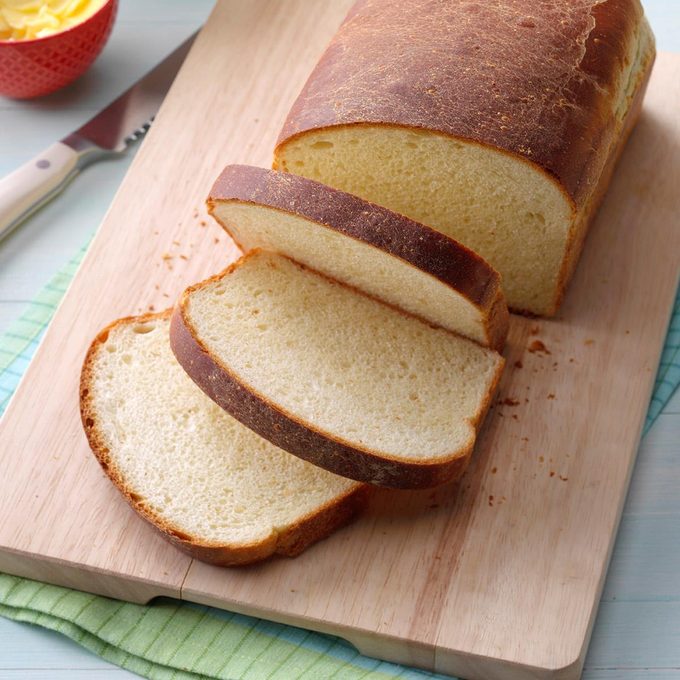
Country White Bread
Anytime is the right time for a comforting slice of homemade bread. These loaves are especially overnice since the crust stays so tender. This white bread recipe is my husband Nick's favorite. He makes about of the staff of life at our business firm. —Joanne Shew Chuk, St. Bridegroom, Saskatchewan
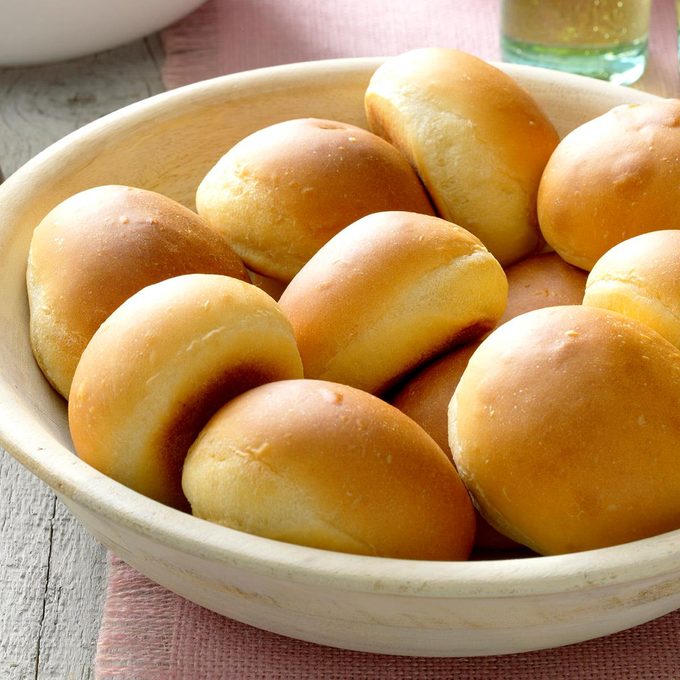
Pillow-Soft Dinner Rolls
The dough for these rolls has a dainty texture and is simple to shape. The recipe came from an sometime church cookbook. —Norma Harder, Weyakwin, Saskatchewan
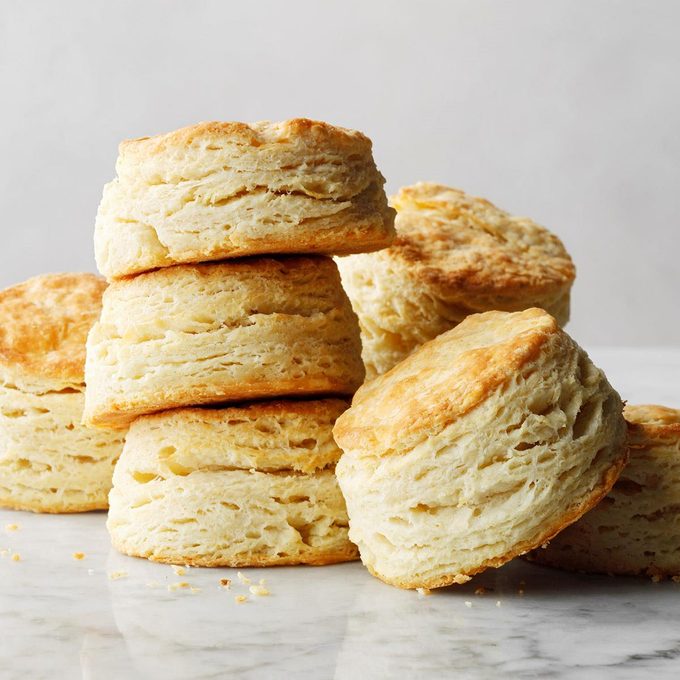
Bootleg Buttermilk Biscuits
The recipe for these 4-ingredient homemade buttermilk biscuits has been handed downwardly for many generations. —Fran Thompson, Tarboro, N Carolina
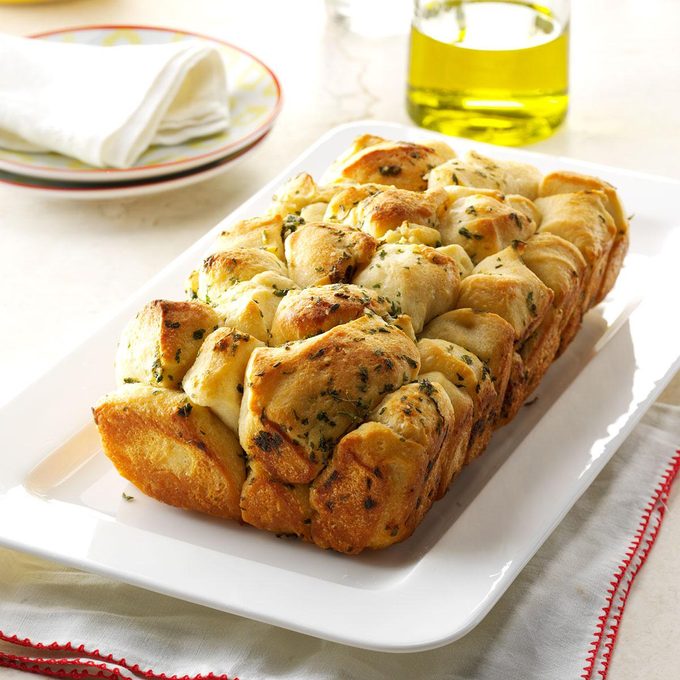
Pull-Apart Garlic Bread
People go wild over this golden, garlicky loaf whenever I serve it. There's intense flavour in every bite. —Ballad Shields, Summerville, Pennsylvania
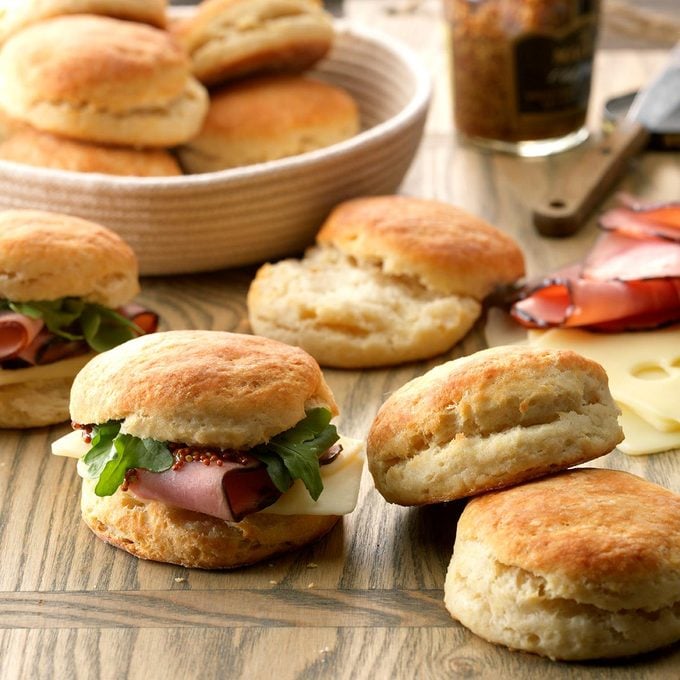
Angel Biscuits
I beginning received a sample of these low-cal, wonderful angel biscuits, along with the recipe, from an elderly gentleman friend. I now broil them often every bit a Saturday-morning treat, served with butter and honey. They're perfect with sausage gravy, too! —Faye Hintz, Springfield, Missouri

Pumpkin Knot Rolls
These rolls are the lightest, near delicious ones I've ever tasted...and everyone else seems to agree. The pumpkin gives them mild flavor, moist texture and a pretty golden color. At our house, it wouldn't be the holidays without them. —Dianna Shimizu Issaquah, Washington

Buttery Bubble Bread
Homemade breadstuff tin can exist time-consuming, hard and catchy to make. But this fun-to-eat monkey staff of life, broiled in a fluted tube pan, is like shooting fish in a barrel and almost foolproof. If I'm serving it for breakfast, I add together some cinnamon and drizzle it with icing. —Pat Stevens, Granbury, Texas
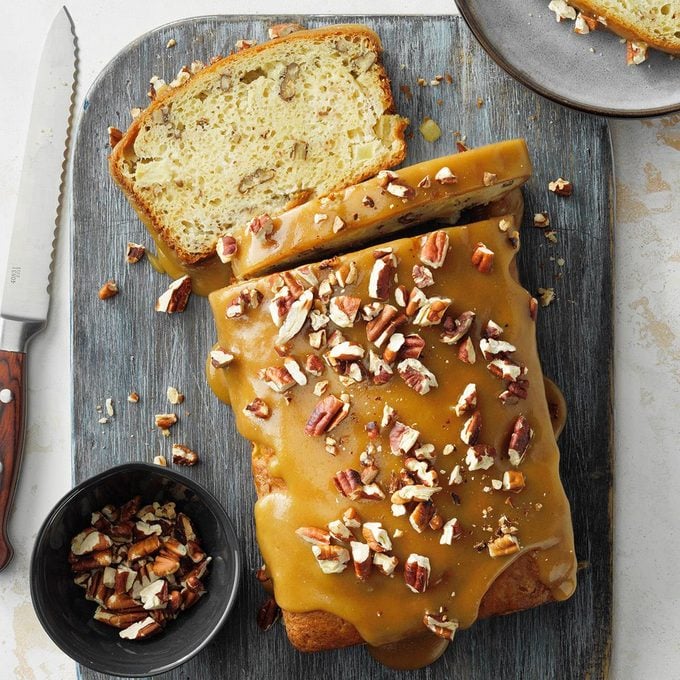
Praline-Topped Apple Bread
Apples, toasted pecans and a praline glaze brand this staff of life perfect for a holiday celebration—or anytime. We similar information technology better than our go-to coffee block. —Sonja Blow, Nixa, Missouri
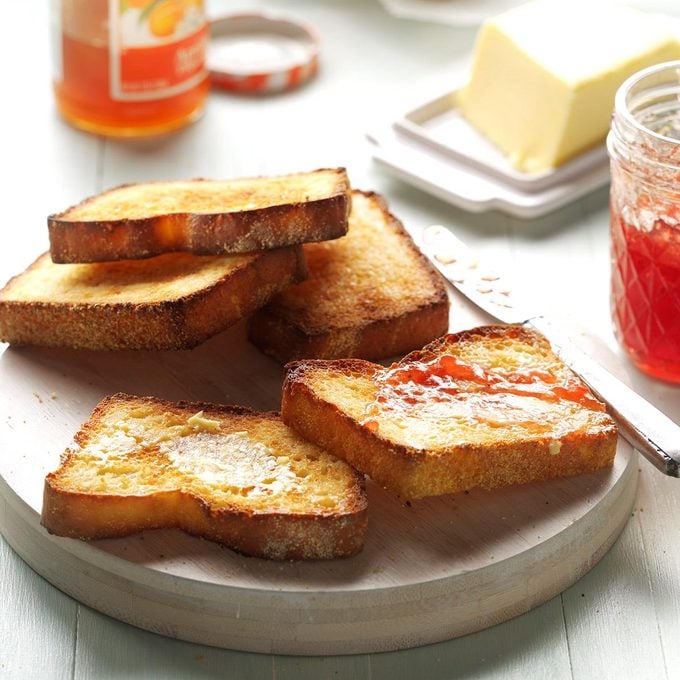
English Muffin Bread Loaf
Many years agone, a proficient friend gave me her female parent'south recipe for this delightful staff of life, and I've made it e'er since. Toast it upwards for breakfast and don't forget to slather on your favorite jam. —Jane Zielinski, Rotterdam Junction, New York
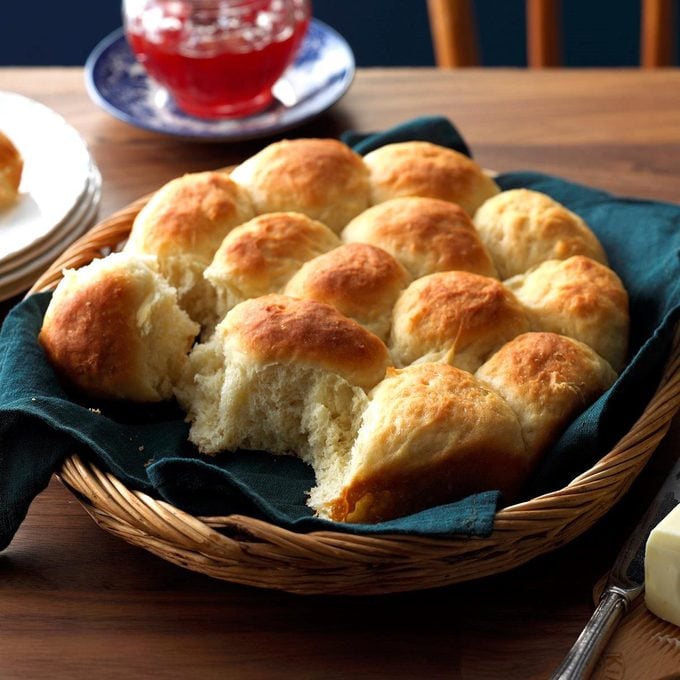
Easy Murphy Rolls
Afterward I discovered this recipe, it became a mainstay for me. I brand the dough ahead of time when visitor is coming, and I try to go on some in the refrigerator to broil for our ranch hands. Leftover mashed potatoes are almost certain to go into these rolls. —Jeanette McKinney, Belleview, Missouri
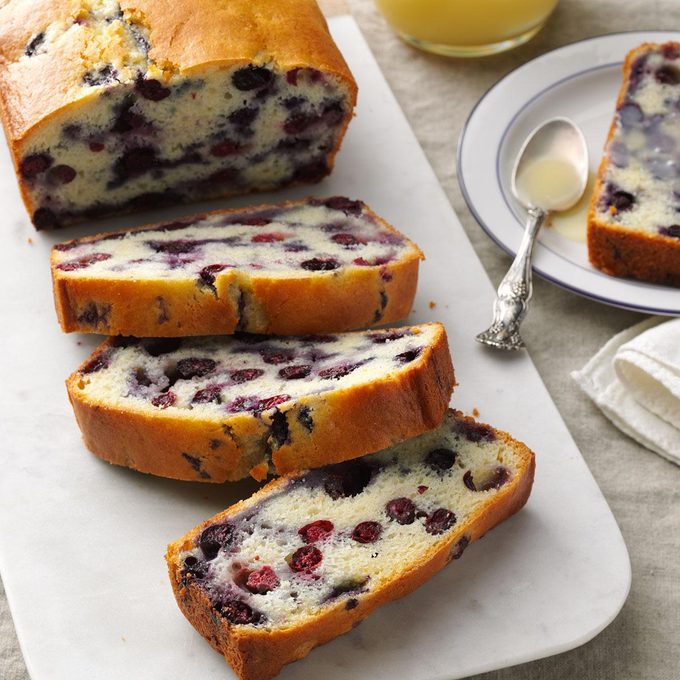
Blueberry Quick Breadstuff with Vanilla Sauce
This loaf is chock-full of blueberries—two whole cups! When you pour the vanilla sauce over the bread, information technology makes it moist--virtually like a pudding. I suggest serving a robust cup of coffee with this delicious treat. —Sue Davis, Wausau, Wisconsin
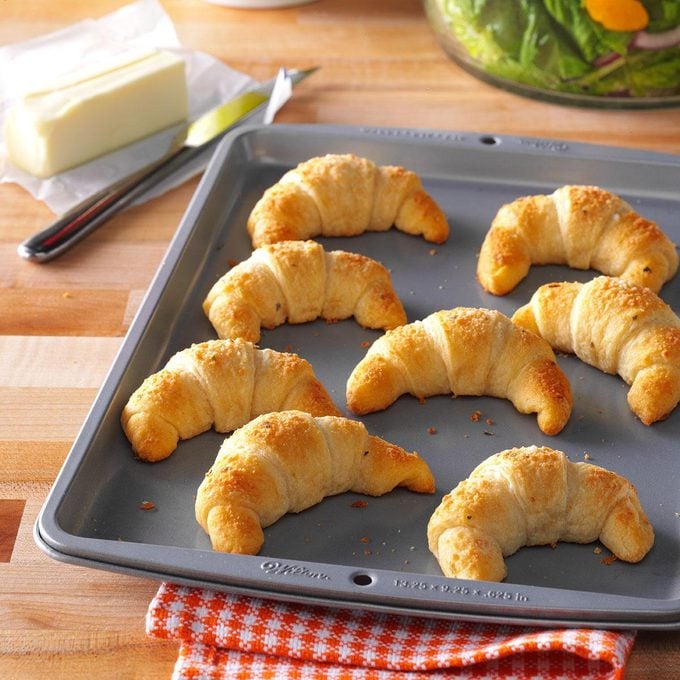
Garlic-Cheese Crescent Rolls
Upgrade your basic crescent roll recipe! Here'southward a recipe that merely couldn't be much quicker or easier and is sure to add a overnice touch to any dinner. The garlic and Parmesan flavors actually come through. Savour! —Lori Abad, E Haven, Connecticut

Milk-and-Honey White Bread
My dad has been a wheat farmer all his life and my land is the wheat majuscule, so this recipe represents my region and my family unit well. This breadstuff never lasts likewise long at our business firm. —Kathy McCreary, Goddard, Kansas
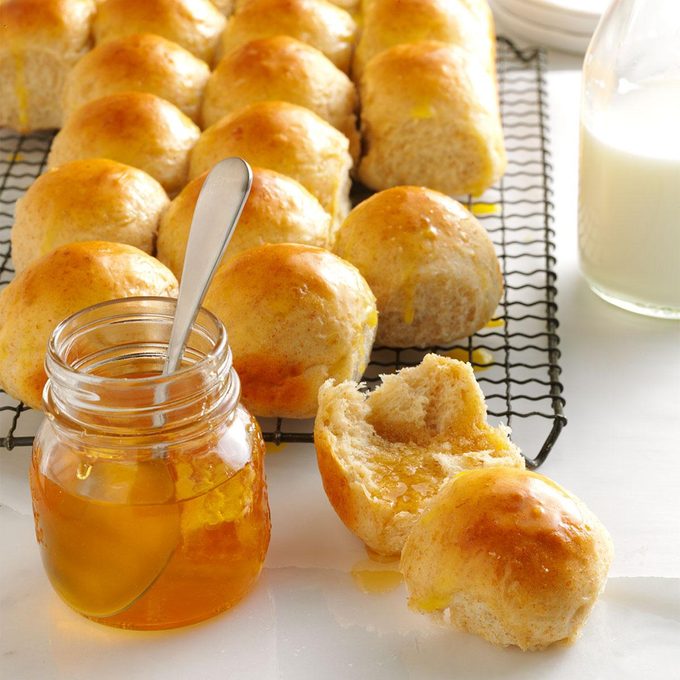
Dear-Oat Pan Rolls
These tender rolls are relatively quick to brand. Whole wheat flour and oats make them nutritious, too.—Arlene Butler, Ogden, Utah
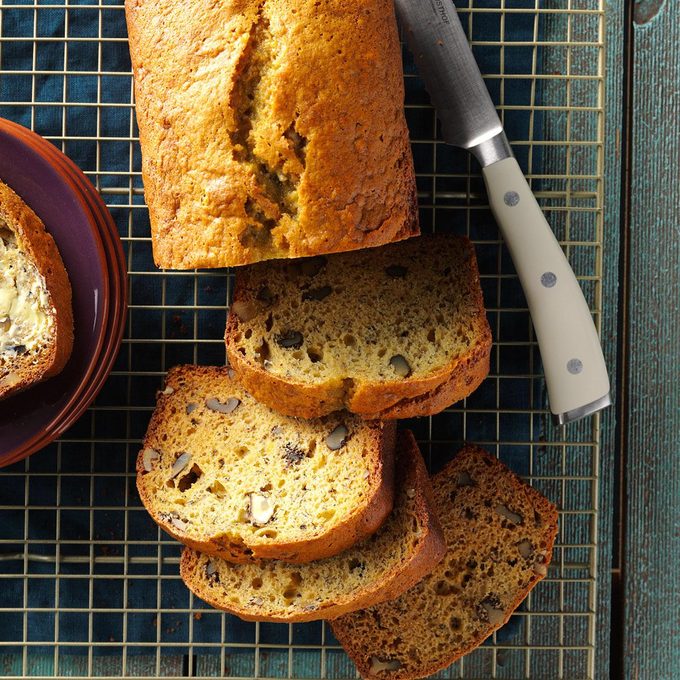
Orange Banana Nut Staff of life
I like this recipe because the orange juice gives the nut bread such a vivid season and besides makes it moist. —Barbara Roethlisberger, Shepherd, Michigan
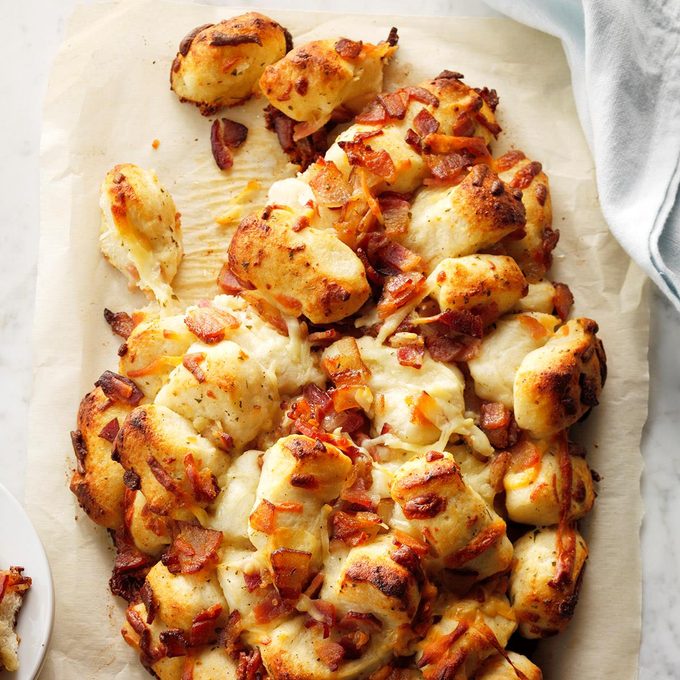
Pull-Apart Bacon Bread
I stumbled across this recipe while looking for something different to take to a brunch. Male child, am I glad I did! Everyone asked for the recipe and was surprised it called for only five ingredients. It'southward the perfect treat to bake for an informal get-together. —Traci Collins, Cheyenne, Wyoming
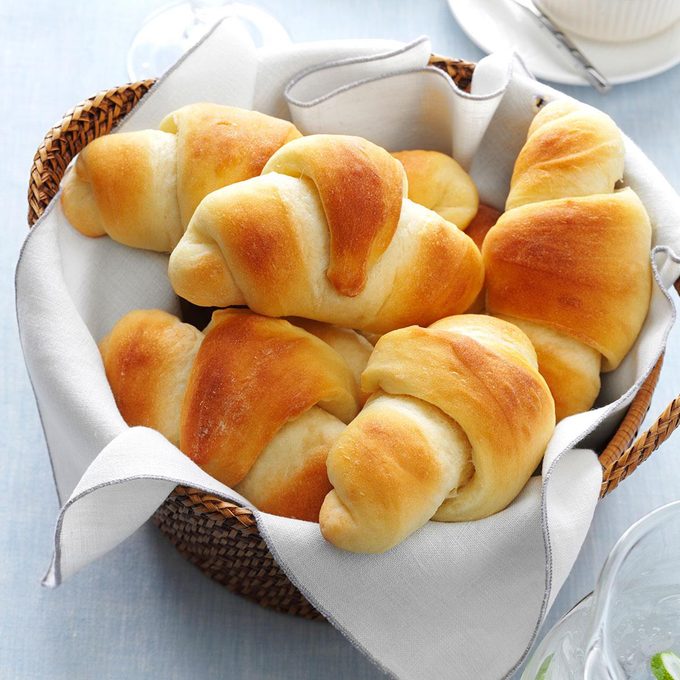
Make-Ahead Butterhorns
Mom loved to make these lightly sugariness, golden rolls. They're beautiful and impressive and have a homemade gustation that makes them memorable. —Bernice Morris, Marshfield, Missouri
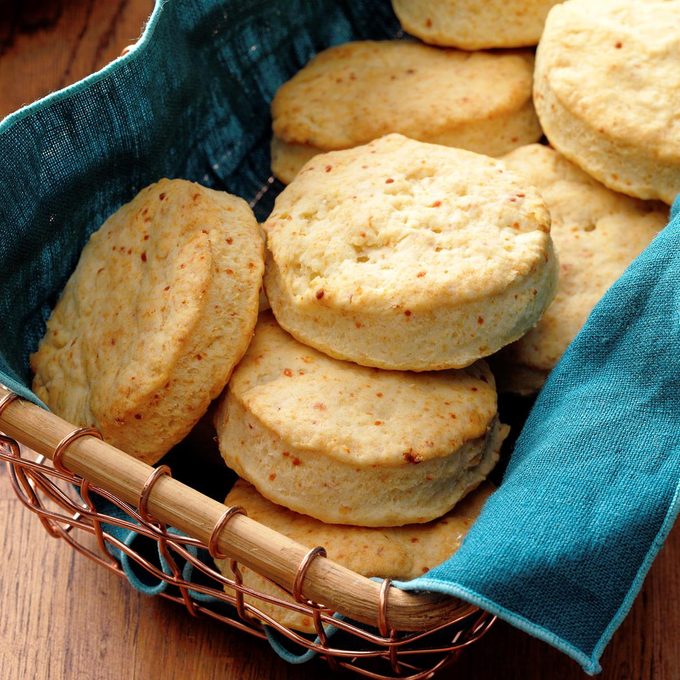
Parmesan Sweetness Foam Biscuits
Sweet foam biscuits were the starting time kind I mastered. Since the ingredients are so elementary, I can scale the recipe up or down. In fact, I've actually memorized it! —Helen Nelander, Boulder Creek, California
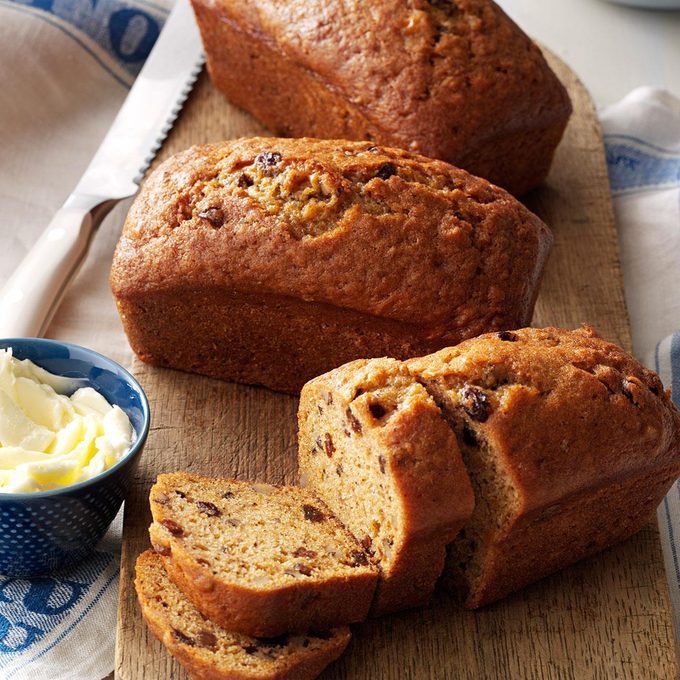
Sweet Potato Cinnamon Bread
My family loves quick breads. This one is moist and spicy. If you don't have mini loaf pans it works simply as well in regular size pans. —Nancy Foust, Stoneboro, Pennsylvania
Potluck Pan Rolls
The appealing homemade yeast-bread season of these gilt rolls is unbeatable. Soft and light, they're great alongside any entree. Folks are disappointed if I don't bring them to potluck dinners. —Carol Mead, Los Alamos, New United mexican states
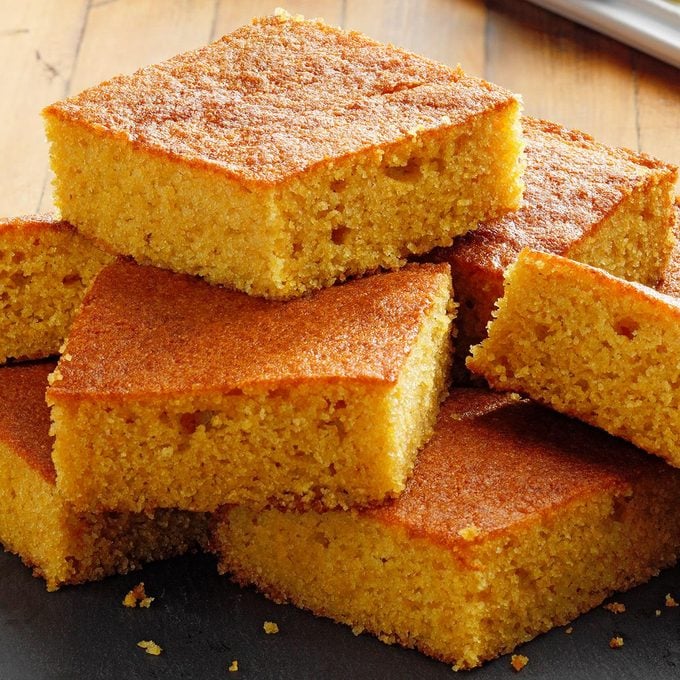
Quick Buttermilk Cornbread
The tattered recipe carte for this buttermilk cornbread proves it'southward been a family favorite for years. It's my daughter's peak request. —Judy Sellgren, Grand Rapids, Michigan
Sesame French Bread
Homemade French bread isn't at all difficult to brand, and it's perfect alongside Italian foods. If you're not serving a large group, freeze one loaf to enjoy later. —Peggy Van Arsdale, Trenton, New Jersey
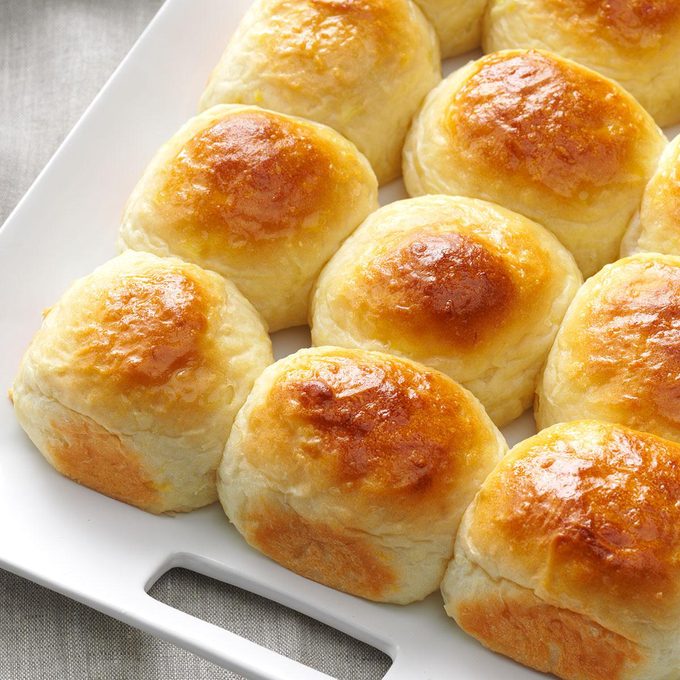
Hawaiian Dinner Rolls
Pineapple and coconut give a subtle sweetness to these golden bootleg rolls. If there are whatsoever leftovers, they're great for sandwiches. —Kathy Kurtz, Glendora, California

Tomato-Herb Focaccia
With its medley of herbs and tomatoes, this rustic bread will liven up any occasion, whether it's a family dinner or a game-twenty-four hours become-together. It never lasts long! —Janet Miller, Indianapolis, Indiana

Sesame Wheat Braids
When I started making this breadstuff, my husband and our half-dozen children liked it so much that I was blistering every day! I was thrilled when the judges at our county fair gave these braids both a blue ribbon and a best of show honour! —Nancy Montgomery, Hartville, Ohio
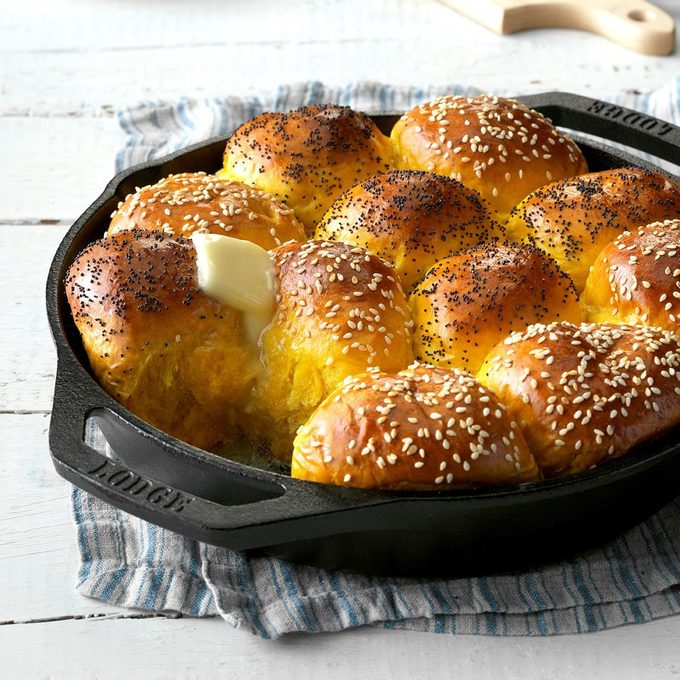
Love-Squash Dinner Rolls
These puffy dinner rolls have on rich colour when you add squash to the dough. Whatsoever squash variety works. I've even used cooked carrots. —Marcia Whitney, Gainesville, Florida
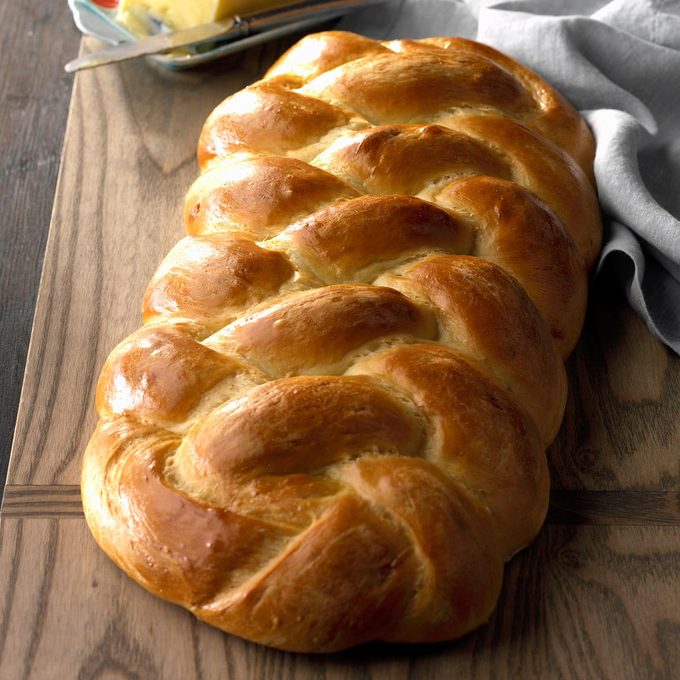
Celebration Braid
During the holidays, I sometimes make a couple of these golden loaves a day to give as gifts. Everyone in our family loves them any time of year. The recipe originated with one for Jewish challah, which I began making over a decade ago. —Marcia Vermaire Fruitport, Michigan

Confetti Cornbread
My grandmother Virginia always served Southwest cornbread. To honor her, I created a recipe that cuts downwards on the chopping but never skimps on flavour. —Angie Price, Bradford, Tennessee
Garlic Herb Bubble Loaf
I adapted an old sour cream staff of life recipe for this deliciously different pull-apart loaf that smells heavenly while blistering. It has a low-cal crust, tender interior and lots of herb and butter flavor. We think it's wonderful with a hot bowl of tater soup. —Katie Crill, Priest River, Idaho
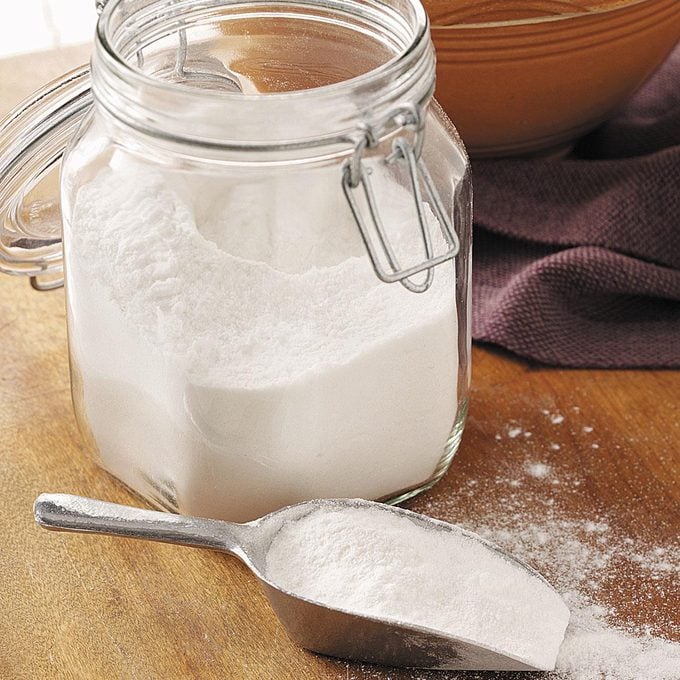
Gluten-Free Flour Mix
I make this recipe in two-quart batches and store them in airtight jars. My son and I both accept celiac disease and love that we tin can utilize this mix to still enjoy traditional dishes. —Bernice Fenskie, Wexford, Pennsylvania
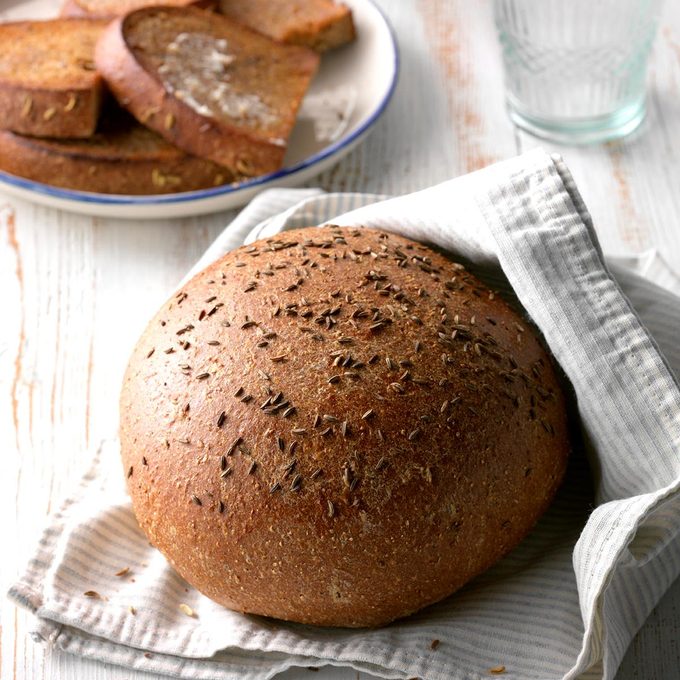
Rustic Rye Bread
This gorgeous rye breadstuff has just a touch on of sugariness and the perfect corporeality of caraway seeds. With a crusty top and house texture, it holds up well to sandwiches, but a pat of butter will do the job, likewise. —Holly Wade, Harrisonburg, Virginia

Flaky Cheddar-Chive Biscuits
These wonderful, buttery biscuits complement any dinner. —Betsy King, Duluth, Minnesota
Autumn Pear Bread
Pears requite these footling loaves delicious flavor and help keep them nice and moist. They brand lovely gifts to share, too. —Mary Lynn Wilson, Linden, Texas

Flavorful Herb Bread
This bread is one of my favorites. It has a wonderful texture and slices beautifully, and the flavour of the herbs really comes through. (Psst—If you don't have a staff of life machine on paw, acquire how to make breadstuff without ane!) —Gerri Hamilton, Kingsville, Ontario
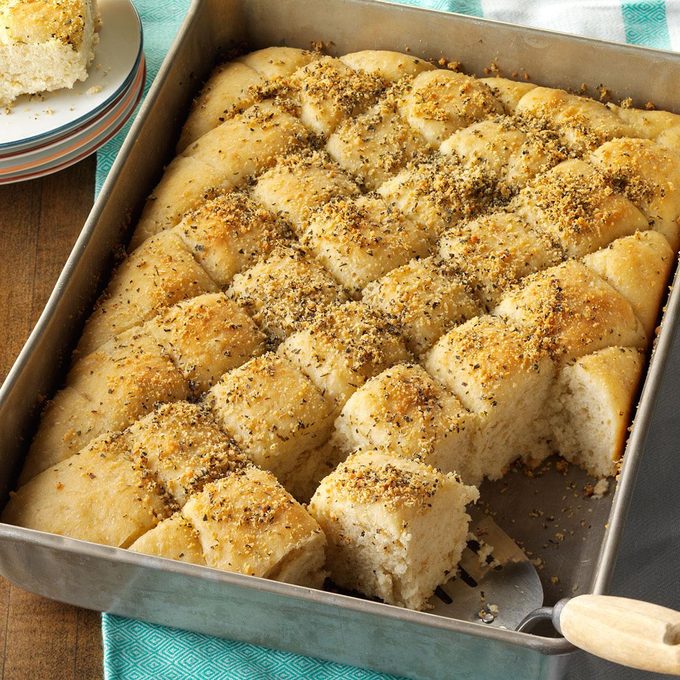
Herbed Oatmeal Pan Bread
This cute, gilt pan staff of life is especially skillful with a steaming basin of homemade soup. The oats give it a distinctive flavor, and nosotros actually like the herb and Parmesan cheese topping.—Karen Bourne, Magrath, Alberta
Soft Sesame Breadsticks
I've been making these tasty breadsticks that go with most any meal for years. Since they utilise ingredients like flour, saccharide, baking powder and milk, it'due south convenient and inexpensive to mix upwards a batch. —Nancy Johnson, Connersville, Indiana
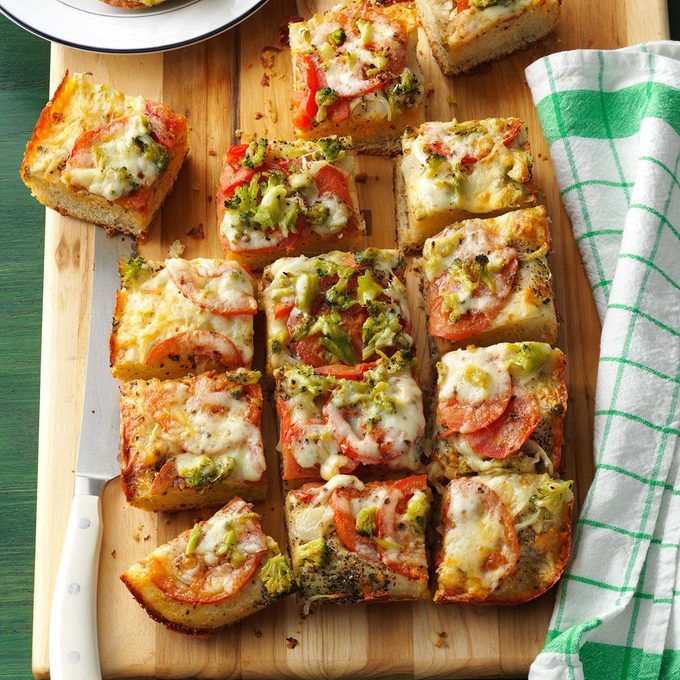
Vegetable & Cheese Focaccia
My family eats this flavorful bread as fast as I tin brand it. Sometimes I add different herbs, red onion or crumbled salary. Information technology's one of my all-time recipes! —Mary Cass, Baltimore, Maryland
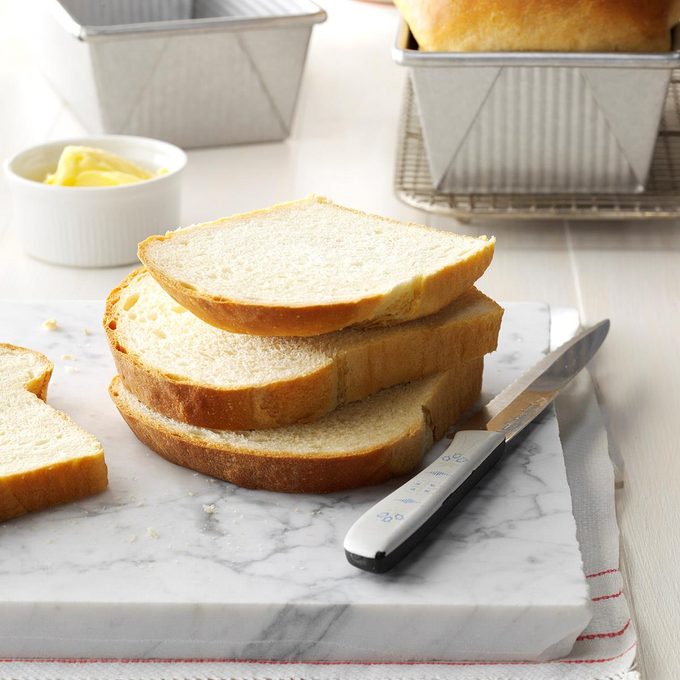
Abode-Manner Yeast Bread
Anybody likes the tender texture and slightly sweet gustation of this homemade bread. When I'm in the mood to bake, I unremarkably double the recipe and share loaves with friends. The dough also makes lovely rolls. -Launa Shoemaker, Landrum, South Carolina

Cornmeal Pan Rolls
These delightful golden rolls are e'er requested at Thanksgiving and Christmas. The recipe is one we've enjoyed for years. —Vivian Eccles, Gridley, Kansas
Caraway Seed Rye Breadstuff
My parents were immigrants from Czechoslovakia and my mother would pull out this rye bread recipe when guests came over for dinner. Every fourth dimension I bake it, I get nostalgic for those days. —Millie Feather, Baroda, Michigan
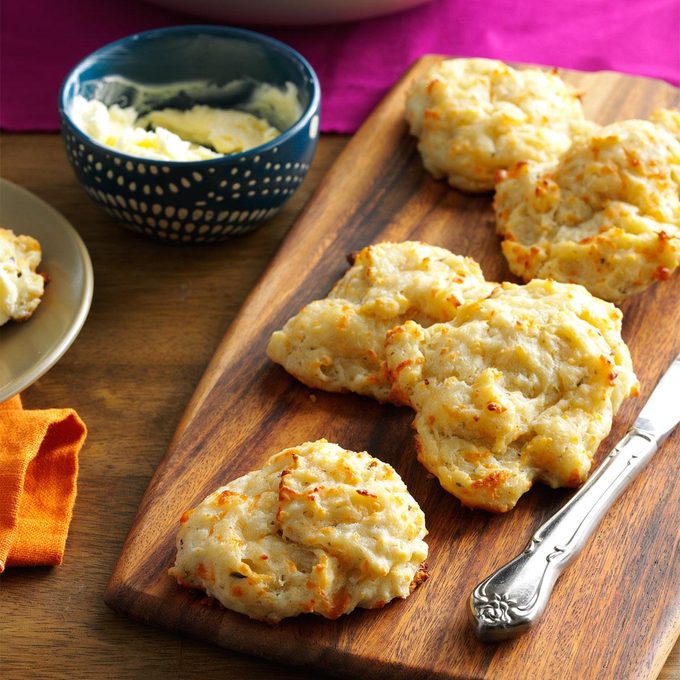
Cheese & Pesto Biscuits
Biscuits always liven upward a meal, especially when they're gold brown and filled with pesto, garlic and cheese for extra zip. —Liz Bellville, Jacksonville, Northward Carolina
Butternut Squash Dinner Rolls
These wholesome rolls are a pleasant add-on to any entree. I get so many requests for them at holiday time. I make nigh 100 dozen in Dec! —Ula Kessler, Freedom Centre, Ohio

Butter and Herb Loaf
This is one of my family's favorite breadstuff recipes. They love it with a warm bowl of soup during autumn.— Lillian Hatcher, Plainfield, Illinois
Oat Pan Rolls
I've made so many of these delicious rolls that I think I could make them blindfolded! I e'er take well-nigh 200 of them to the senior citizens dinner at our church building. After shaping the rolls, you can freeze them, then just thaw and broil when you need them. —Debbie Johnson, Centertown, Missouri
No-Knead Casserole Breadstuff
You lot'll love this cheddar bread fabricated in a casserole dish. It is one of the easiest yeast breads to brand. And since it calls for rapid-ascension yeast, yous don't have to look long to enjoy information technology! —Peggy Key, Grant, Alabama
Handy Sausage Biscuits
These are similar to old-fashioned biscuits made from scratch, only they're even better thanks to the tasty sausage throughout. It'due south well-nigh impossible to stop eating them. I like to serve these biscuits with an egg dish or soup. —Nancy Parker, Seguin, Texas
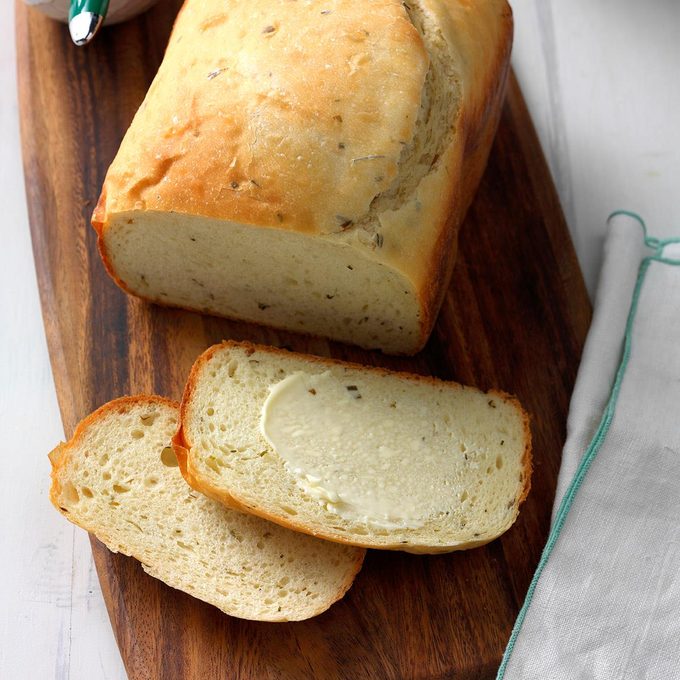
Sour Cream Chive Bread
This savory loaf mildly flavored with chives is delicious when served warm with a meal, soup, salad or stew. It as well tastes wonderful toasted the next mean solar day for breakfast. —Deborah Plank, Due west Salem, Ohio
Honey Spice Bread
The texture of this bread is almost like a cake, and then I usually serve slices of information technology for dessert. The loaf looks so festive with the pretty glaze drizzled on top. —Gaye O'Dell, Binghamton, New York
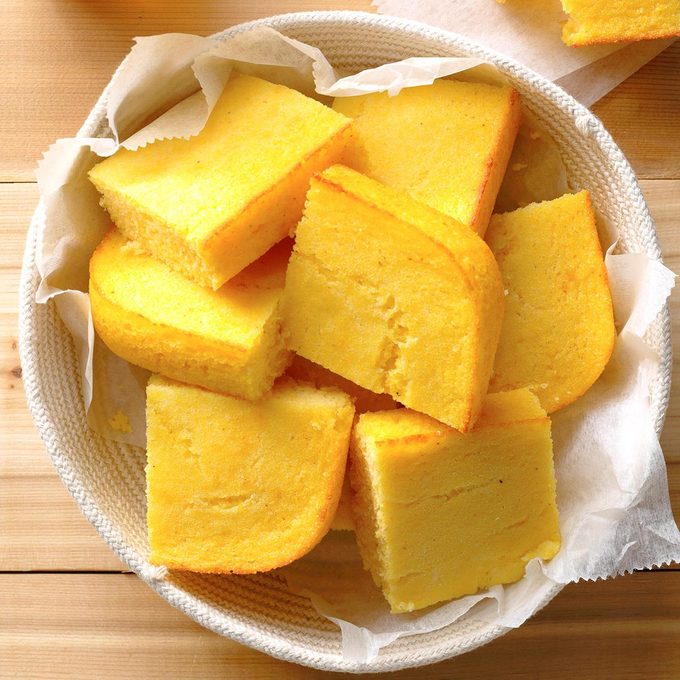
Yogurt Cornbread
My husband doesn't similar traditional Texas corn bread, so I came up with this recipe. This is the only kind he'll swallow. Yogurt makes this variation different from most. —Amanda Andrews of Mansfield, Texas
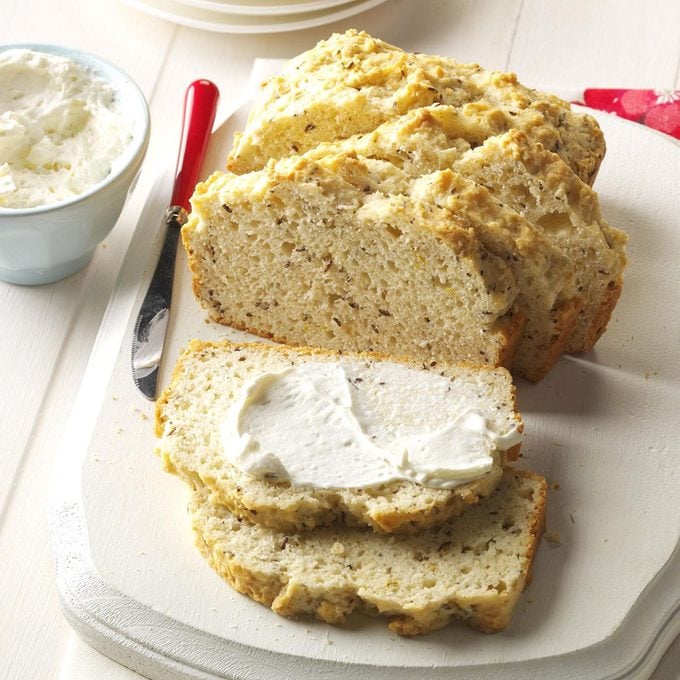
Herb Quick Staff of life
This simple bread is specially good with soups and stews, but slices are also tasty alongside fresh dark-green salads. The herbs brand information technology a flavorful treat any time of the year. —Donna Roberts, Manhattan, Kansas
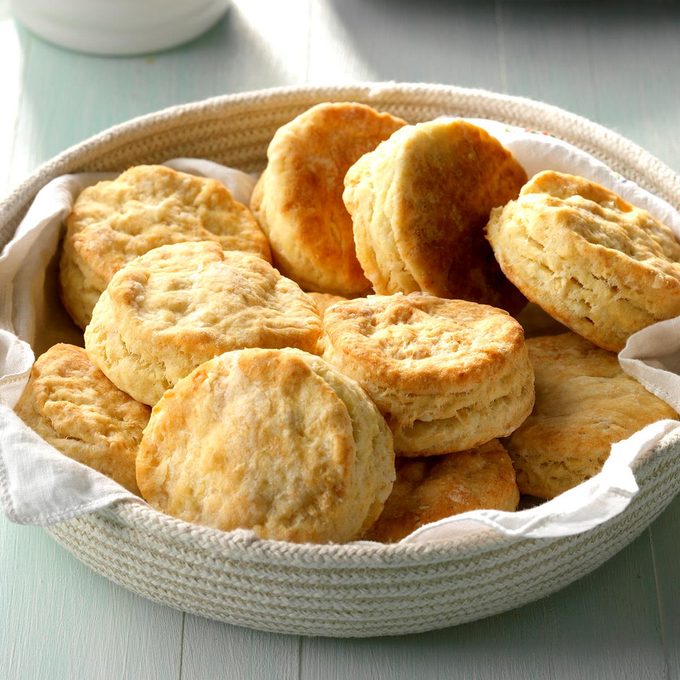
Mom's Buttermilk Biscuits
These fluffy biscuits are so tasty slathered with butter or used to mop up every terminal drop of gravy off your plate. I tin all the same see Mom pulling these tender gems out of the oven. —Vera Reid, Laramie, Wyoming
Whole Wheat French Breadstuff
The first time I made this recipe my married man asked information technology if was homemade or store-bought. When he reached for a second slice, I knew I had a winning recipe. —Roseann Loker, Colon, Michigan
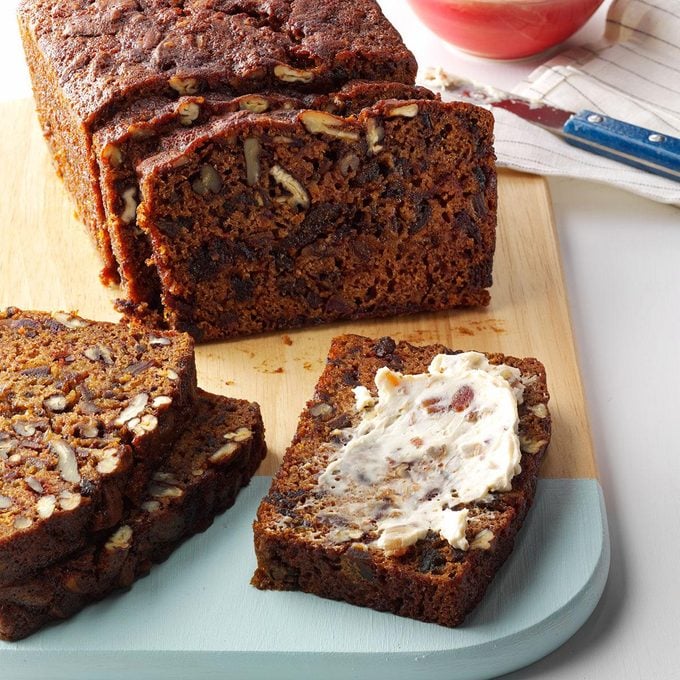
Date Pecan Tea Bread
Packed with dates and pecans, this sweetness staff of life is excellent on its ain and even amend topped with the chunky cream cheese spread. We savor it during the holiday flavor, simply as well for afterwards-schoolhouse and late-night snacks. —Carole Resnick, Cleveland, Ohio
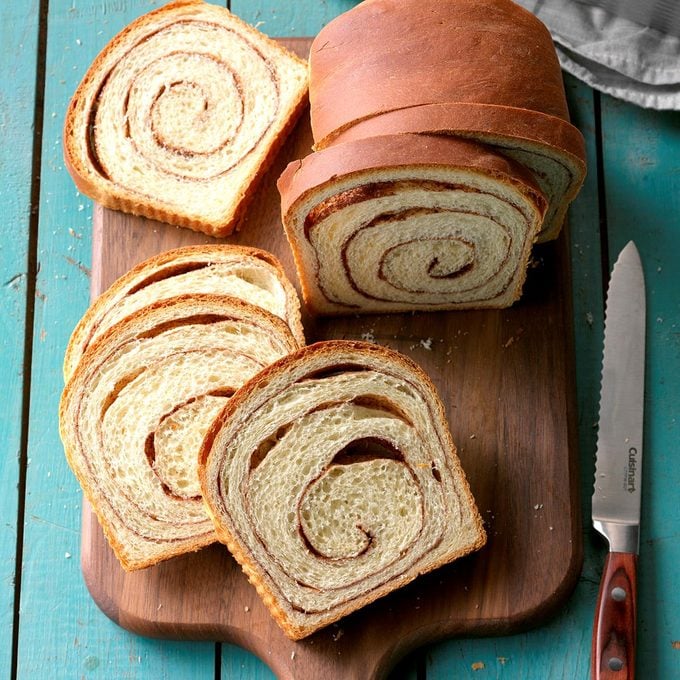
Cinnamon Swirl Bread
Your family unit will be impressed with the soft texture and appealing swirls of cinnamon in these lovely breakfast loaves. —Diane Armstrong, Elm Grove, Wisconsin
Wholesome Wheat Bread
My sister and I were in iv-H, and Mom was our breads project leader for years. Because of that early on training, fresh homemade breadstuff similar this is a staple in my ain kitchen. -Karen Wingate, Coldwater, Kansas
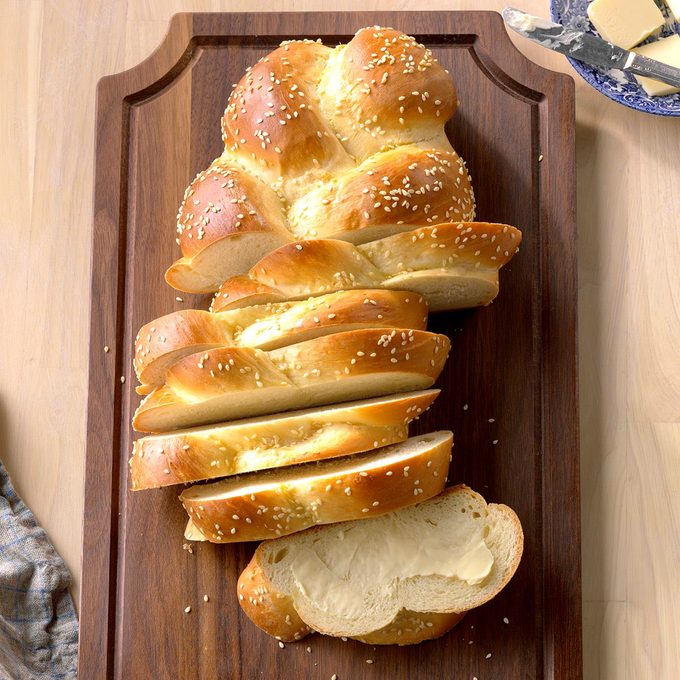
Homemade Egg Bread
People rave nearly this tender, delicate bread every time I serve it. The braided look is just beautiful and is actually quite easy to do. —June Mullins, Livonia, Missouri
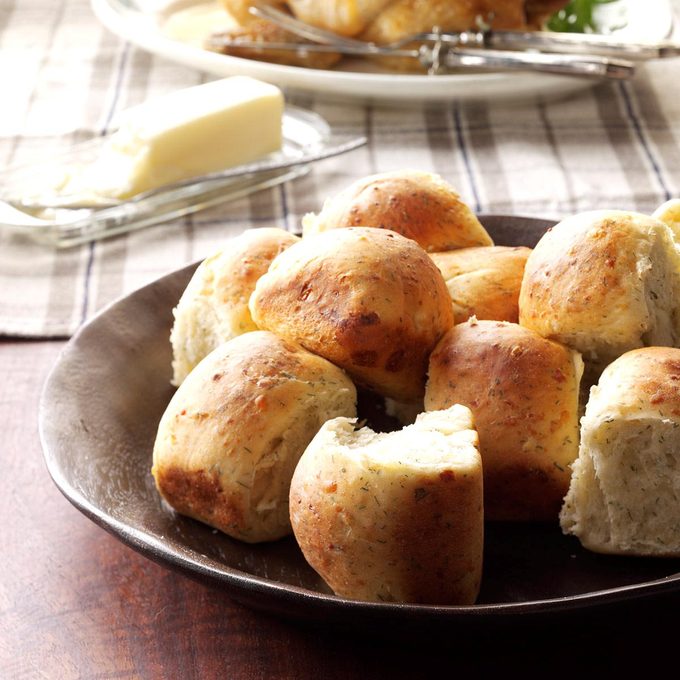
Dilly Rolls
These versatile rolls are and then welcome served warm alongside whatever dinner. I always make a big batch since my family unit enjoys them after they're cool, too, stuffed with a filling like egg salad or ham salad. —Mary Bickel, Terre Haute, Indiana
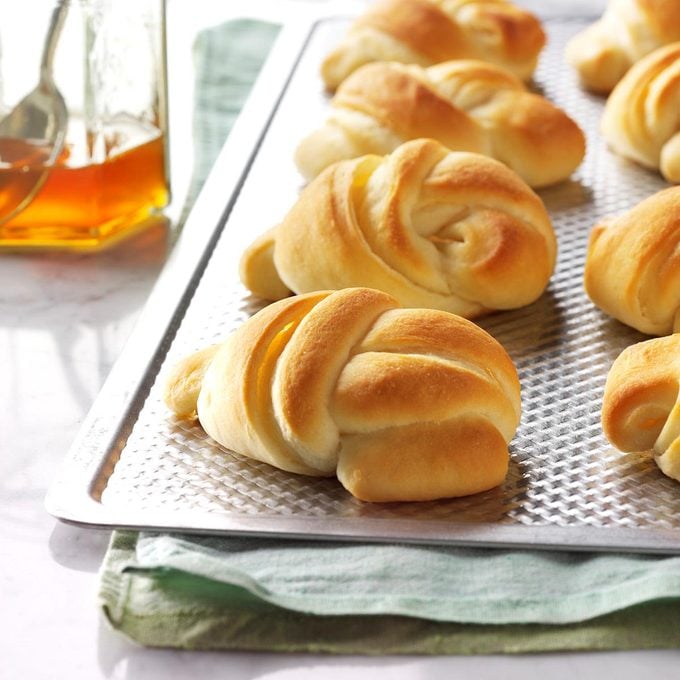
No-Knead Knot Rolls
My mom, Velma Perkins, loved to serve these light, golden rolls when I was growing upwards on our Iowa farm. They're extra nice since they require no kneading. The dough rises in the refrigerator overnight, and so there's little last-infinitesimal fuss to serve fresh hot rolls with any meal. —Toni Hilscher, Omaha, Nebraska
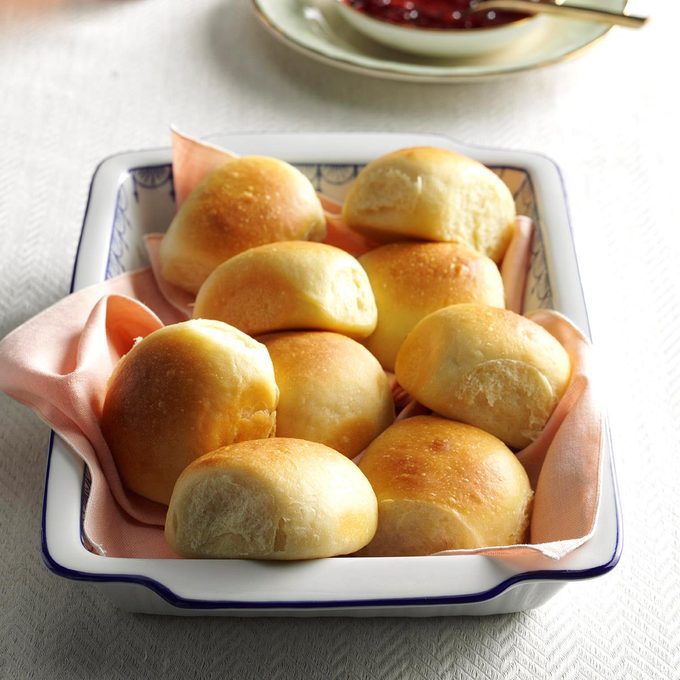
Soft Buttermilk Dinner Rolls
Warm, buttery dinner rolls are admittedly irresistible. I relieve time and utilize a stand mixer to make my dough. —Jennifer Patterson, Shoshone, Idaho
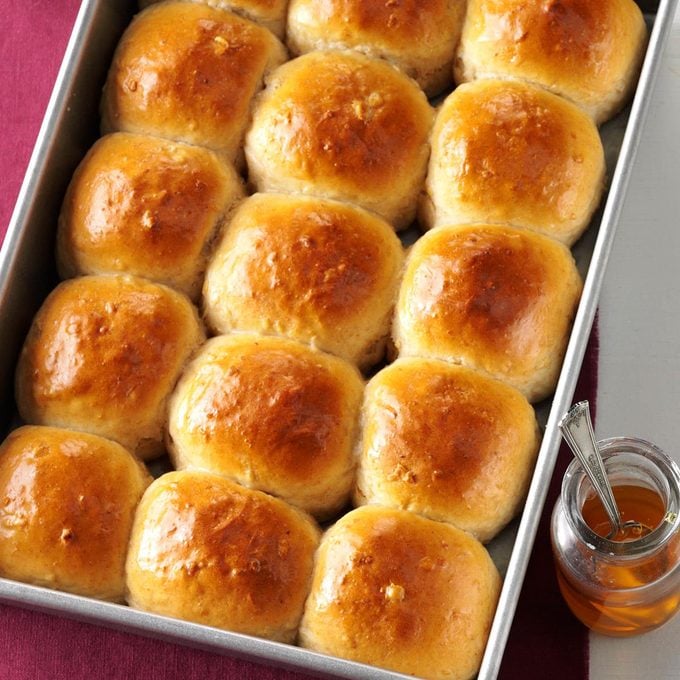
Love Whole Wheat Rolls
Most of the farmers in our area grow wheat, so this recipe definitely represents my region. I bake these rolls oftentimes, particularly when I'g making soup or stew. —Celecia Stoup, Hobart, Oklahoma
Wonderful English Muffins
When I was growing up on a farm, my mom always seemed to be making homemade bread...cypher tasted so practiced! At present I like to make these simple nonetheless succulent muffins for my own family. —Linda Rasmussen, Twin Falls, Idaho
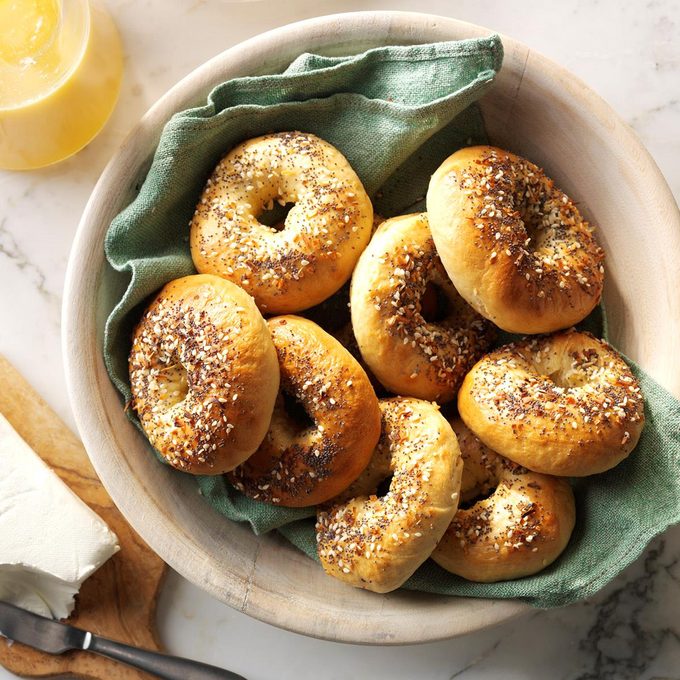
Dearest Bagels
Who has time to brand from-scratch bagels? Yous do, with this piece of cake recipe! The chewy gilt bagels offering a hint of honey and volition win over even the pickiest eaters. —Taste of Dwelling Examination Kitchen
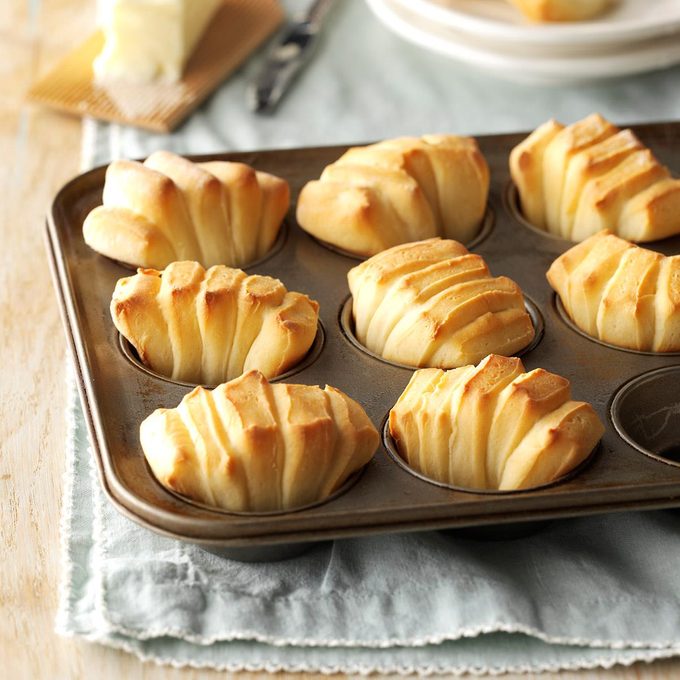
Sour Foam Fan Rolls
I received this recipe from an email pen pal in Canada. The dough is and so easy to piece of work with, and it makes the lightest yeast rolls. I haven't used another white breadstuff recipe since I started making this one. -Carrie Ormsby, W Jordan, Utah
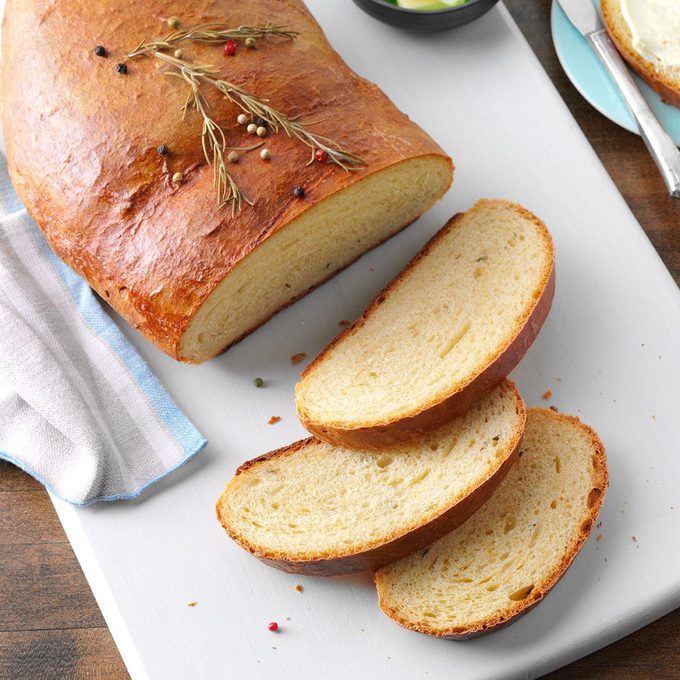
Rosemary Orange Bread
Encounter the Cook: Of all the herbs, rosemary is my favorite. This bread goes dandy with a roast, craven or pasta with red sauce. Information technology's peculiarly festive to serve at holiday time. My husband and I have three young children - ages 6, 3 and i. -Deidre Fallavollita, Vienna, Virginia

Italian Pinwheel Rolls
An enticing combination of Parmesan cheese, oregano and garlic makes these buttery rolls impossible to resist. The aroma that wafts through the house while they are baking is incredible. —Patricia FitzGerald, Candor, New York
Feather-Low-cal Biscuits
I usually used a glass as a cutter so the biscuits are bigger than boilerplate size, and I e'er baked some extras to ship home with the kids. They liked to split them and fill up them with cheese or peanut butter and strawberry jam. —Eleanore Colina, Fresno, California
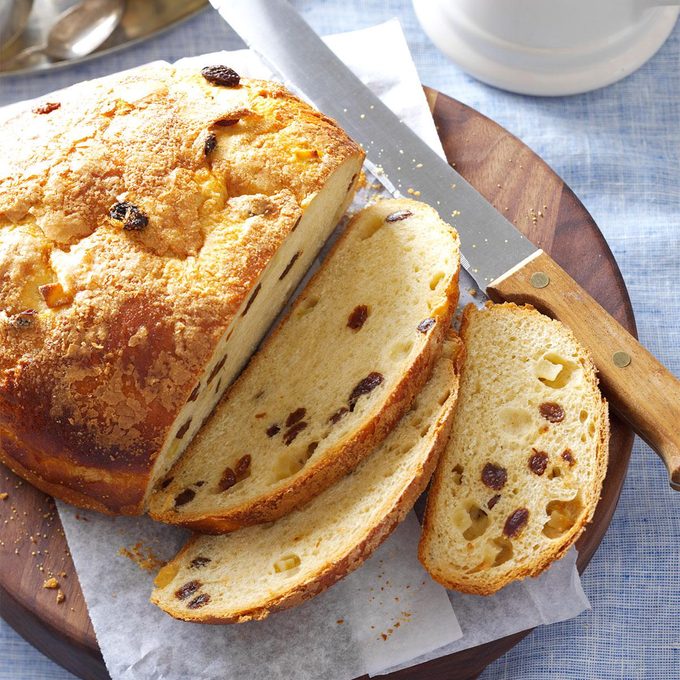
Apple Raisin Breadstuff
I've been making this bread for many years. Information technology smells then practiced in the oven and tastes even ameliorate. I brand bread virtually every Sat, and information technology doesn't stay around long with our sons home from college in the summertime. —Perlene Hoekema, Lynden, Washington
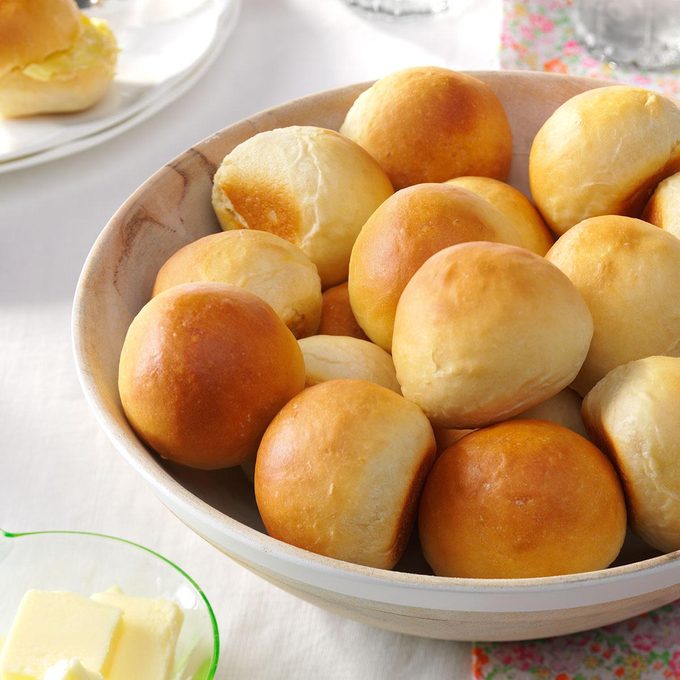
Overnight Yeast Rolls
Information technology's like shooting fish in a barrel to make light and flavorful rolls with this no-fuss recipe. The dough can also be used for cinnamon rolls, herb bread or coffee cake. —Trisha Kruse, Eagle, Idaho
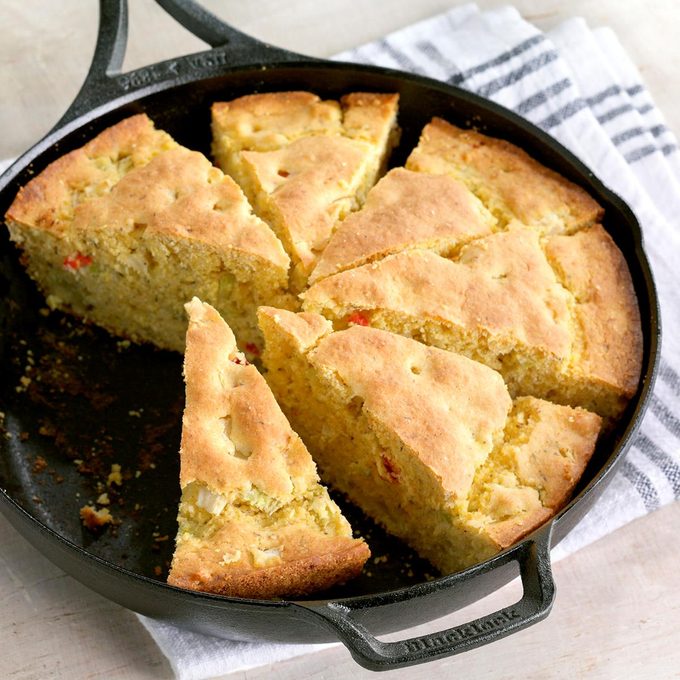
Skillet Herb Bread
We had a lot of family get-togethers while I was growing upwards. My grandmother, aunts and mom were all skillful cooks, and each had her own specialty when it came to staff of life. Mom'southward was my favorite—she created this recipe more than 40 years ago. The flavors call to mind the taste of cornbread stuffing! —Shirley Smith, Yorba Linda, California
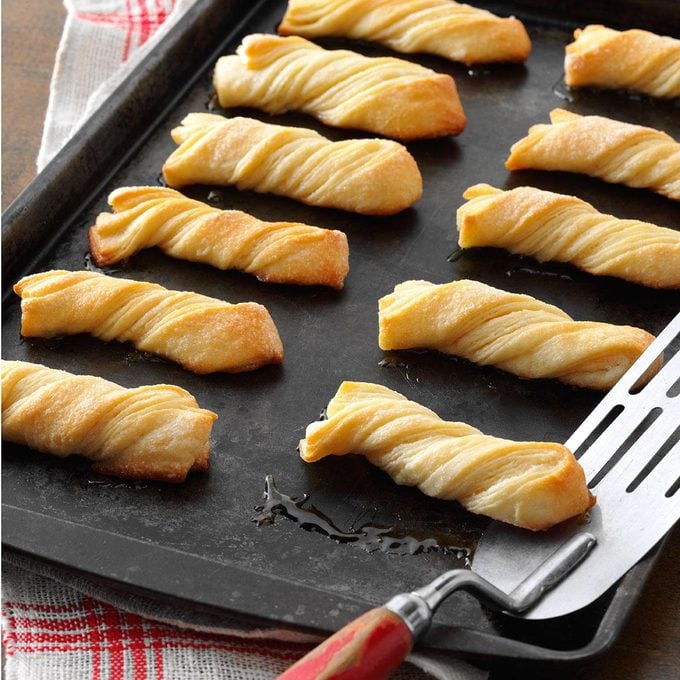
Evelyn'southward Sour Cream Twists
"Evelyn" is my mother-in-law, who always keeps some of these terrific flaky twists in her freezer to serve in a compression. They go quickly around our house— especially during the holidays.
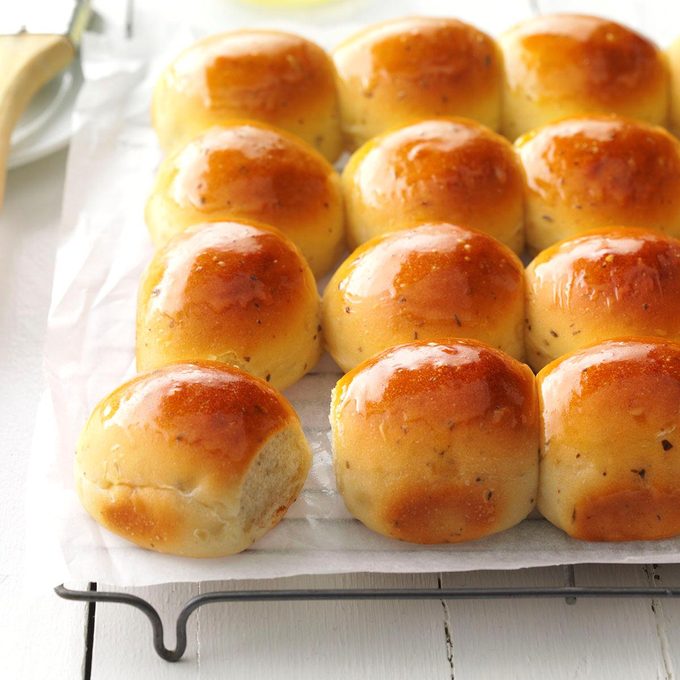
Herb Buttermilk Dinner Rolls
When I couldn't find a recipe for dinner rolls, I created my own using a variety of herbs for extra flavor. —Sue Friesen, Thorold, Ontario

Elvis Banana Breadstuff
As a toddler, my son loved bananas, so we e'er had them in the house. Nosotros didn't always swallow them all earlier they were also ripe, then we experimented across basic banana bread. That'south how we came up with Elvis breadstuff! —Liz Somppi, Greenfield, Wisconsin
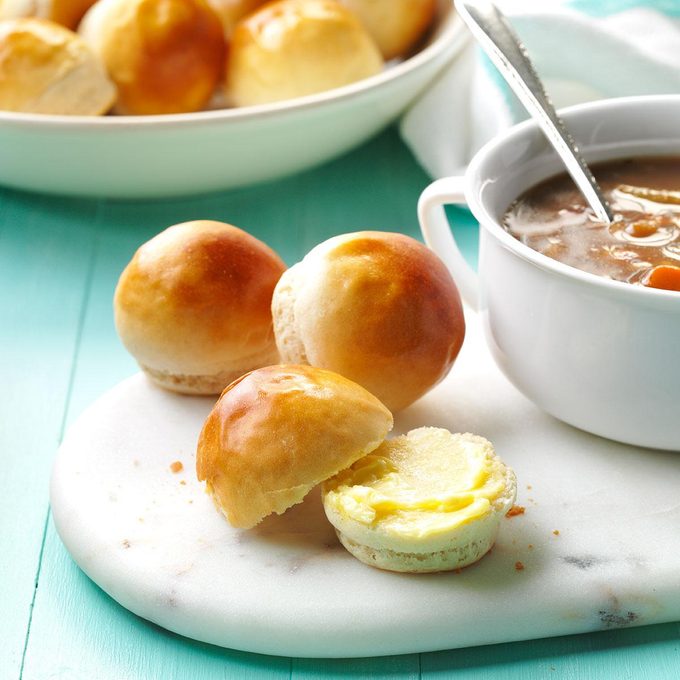
Extra Quick Yeast Rolls
Making bootleg rolls normally takes a lot of ingredients and time, but this recipe makes it so unproblematic. They come together quickly and they freeze well too.—Eleanor Paine, Junction Urban center, Oregon
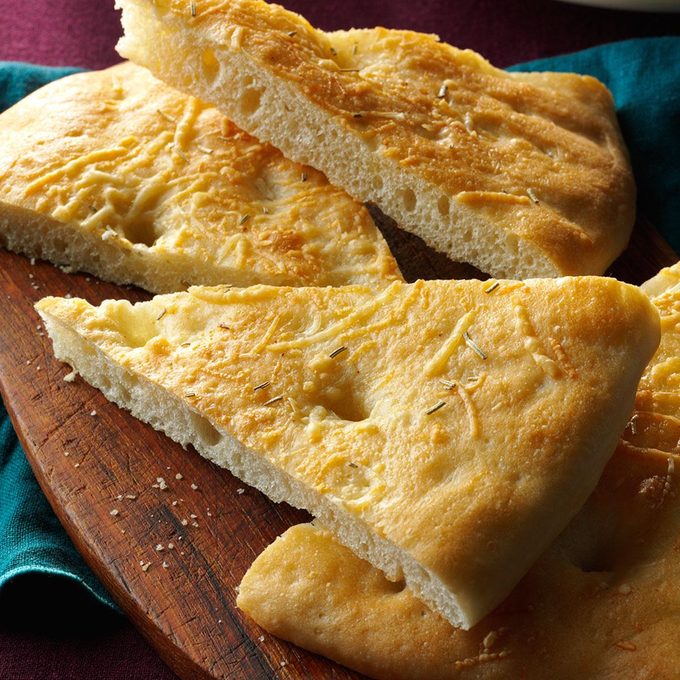
Italian Flatbreads
Pairs wedges of this chewy flatbread with a tomato-based soup and showtime dunking! —Cynthia M. Bent, Newark, DE

Cardamom Braid Breadstuff
I came across this recipe in 1983 and have been making it for the holidays ever since. 1 twelvemonth I gave abroad 20 loaves! —Rita Bergman, Olympia, Washington
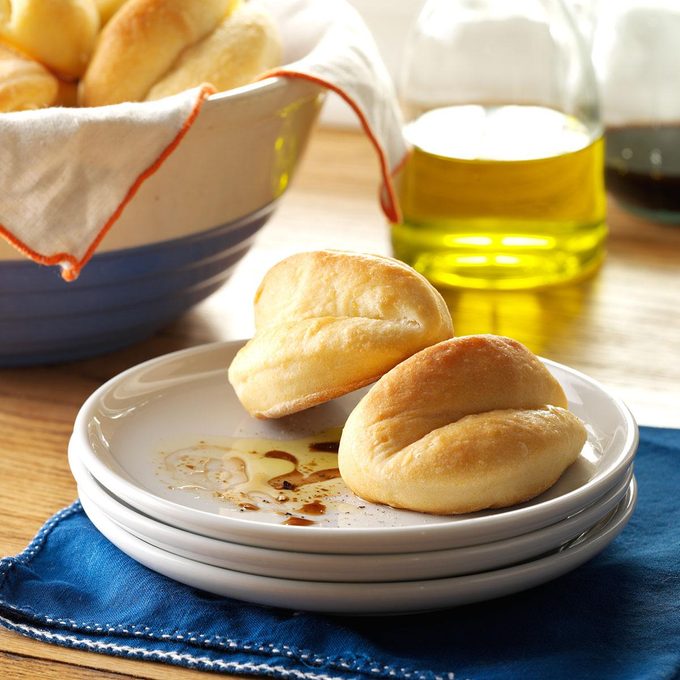
Cornmeal Parker House Rolls
My mom deserves the credit for making this recipe a family tradition. These sweetness, tender rolls take been on every holiday table at her house for every bit long every bit I can remember. —Lisa D. Brenner, Harrisburg, Nebraska
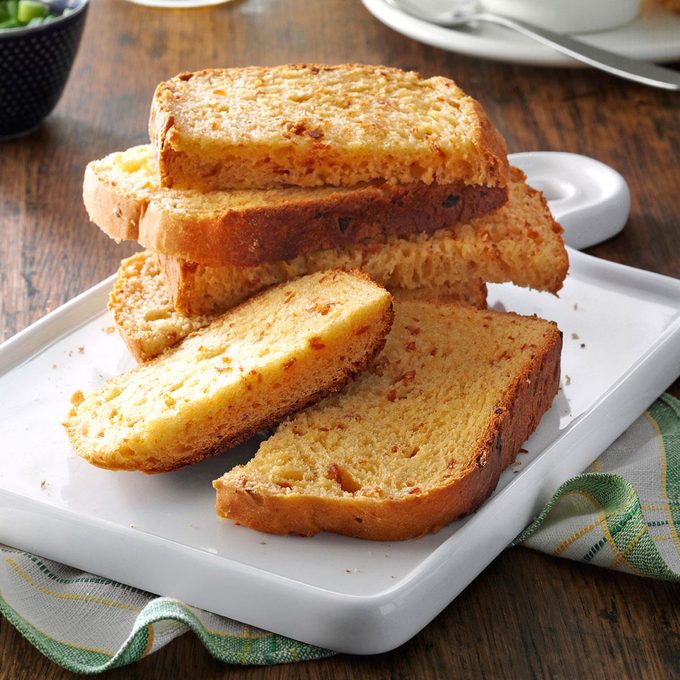
Pepperoni Cheese Breadstuff
As a stay-at-habitation mother of two petty girls, I pack a lot of activity into my days. The bread car makes it a snap to plough out this attractive loaf that gets its zip from cayenne pepper, pepperoni and Mexican cheese. —Dusti Christensen, Goodridge, Minnesota
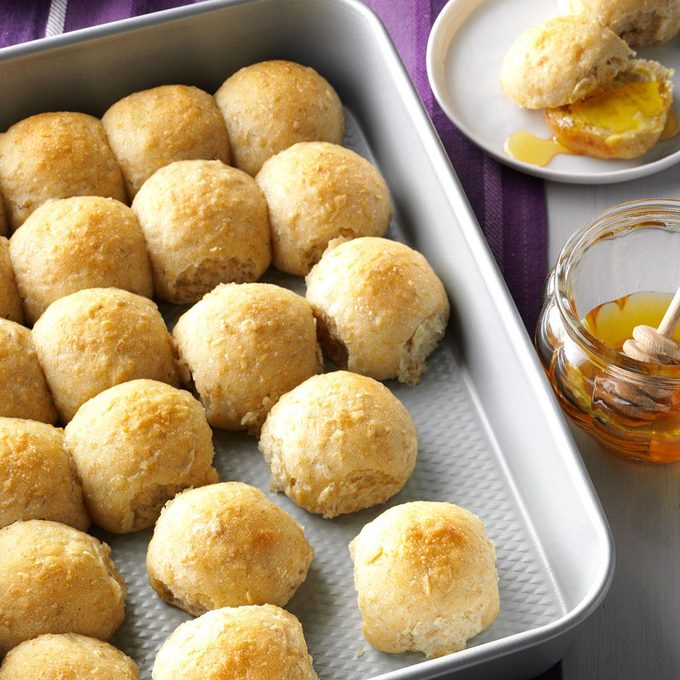
Scottish Oatmeal Rolls
My family likes rolls that can concord up to scooping gravies, sauces and more. This recipe is a favorite. The oatmeal in the dough gives information technology a Scottish touch. —Peggy Goodrich, Enid, Oklahoma
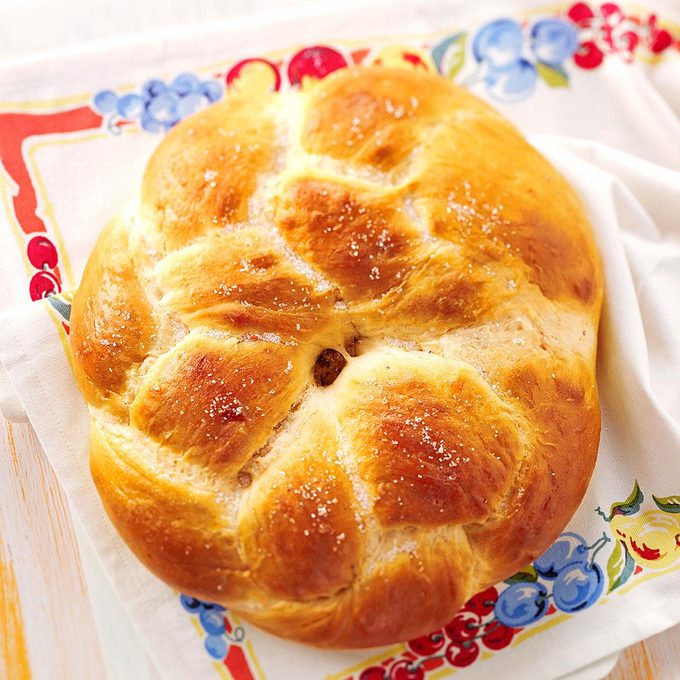
Cardamom Twist
This aureate bread has a soft, tender texture and the perfect amount of cardamom flavour in every bite. Slices are particularly adept with a foam cheese spread or fresh honey butter. —Carla Miller, Pasco, Washington

Tender Whole Wheat Rolls
Even though these are whole wheat rolls they have a light texture and are soft and tender. This recipe reminds me of lots of happy meals with my family unit.—Wilma Orlano, Carroll, Iowa

Muenster Staff of life
Many years ago my sis and I won blueish ribbons in 4-H with this bread. The recipe makes a beautiful gilt loaf with cheese peeking out of every slice. —Melanie Mero, Ida, Michigan
Wild Rice Bread with Sunflower Seeds
I loved skipping the slow school deli meals and going to my grandma'due south house for lunch. She spent most of her life in northeastern Minnesota, which is reflected in this bread'south ingredients. Now my family uses this for our holiday stuffing. —Crystal Schlueter, Northglenn, Colorado
Up Adjacent: The Best Breadstuff Recipes of 2021

























































































